Annual Report 2022



AGES’ offers large-series production of advanced precision components to leading players in selected customer segments. Driven production processes, an entrepreneurial spirit and cutting edge technological expertise create the conditions necessary to deliver the best solutions on the market while also ensuring cost-efficiency in production.

AGES is a Swedish industrial group with seven manufacturing units in Sweden and one in China. The company’s own production concentrates on the manufacture of medium-sized to large series of products with extremely stringent quality requirements. We also offer international trading operations, a broad spectrum of quality products from a large and expanding network of sub-suppliers. Our primary customers are in the automotive and engineering industries in Europe. We are a leading player with a clear focus on customer benefit, development opportunities and competitive solutions. Continuous investments in automated production equipment, in particular, ensure that our production
Die casting
AGES specialises in die casting of aluminium and associated post processing.
Machining
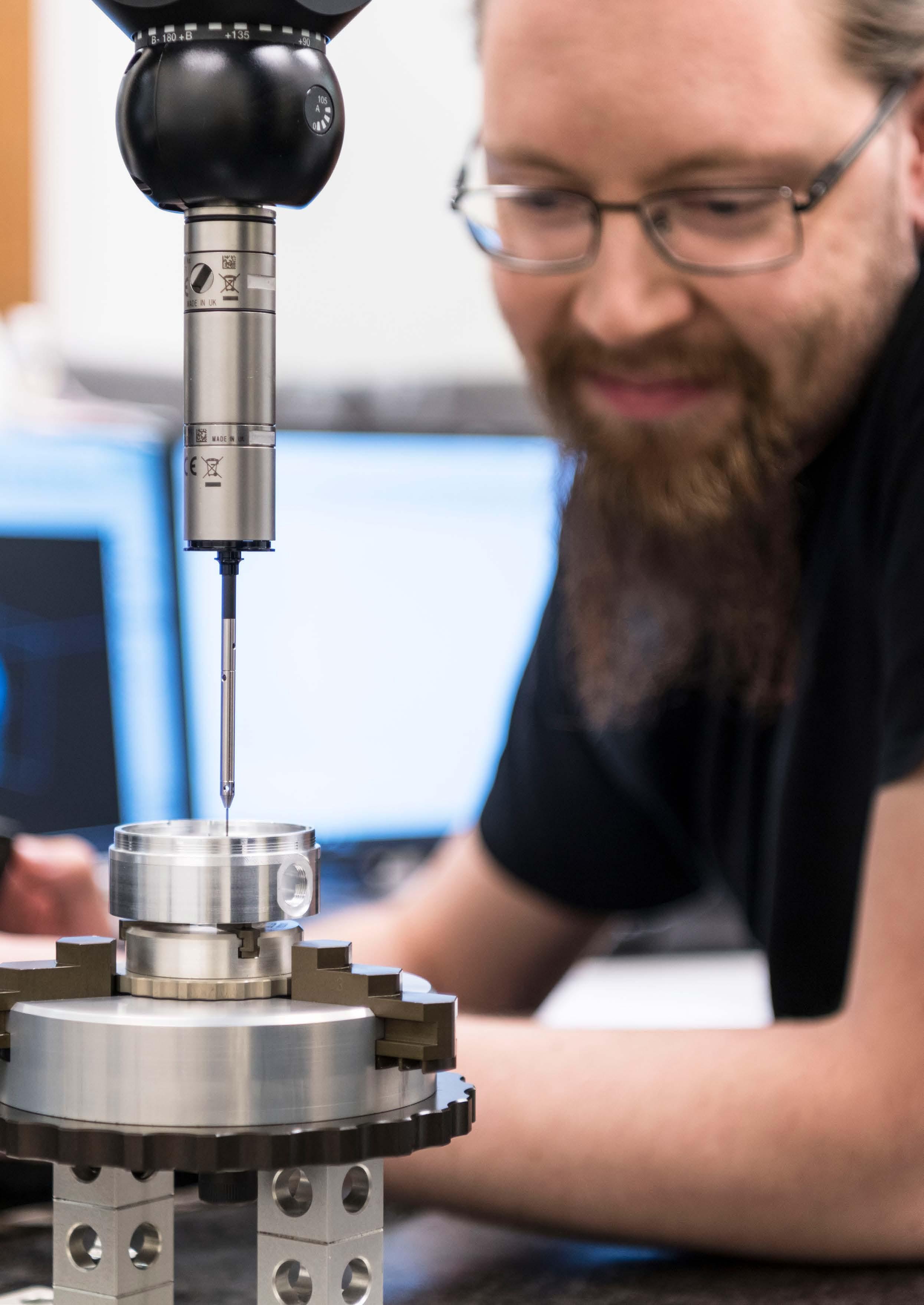
AGES supplies components produced through machining of materials such as steel, stainless steel, brass and aluminium.
Welding
AGES performs robot welding and manual welding of advanced, highprecision products.
Tooling
AGES designs and manufactures quality tools for die casting of aluminium which meet stringent market requirements.
Assembly
AGES performs assembly in which the majority of the material used comprises self-produced components.
AGES is a full service provider (FSP), which means we take overall responsibility, making things easier for our customers. A onestop shop where everything is available from a single group. We guarantee quality in term of deliveries, lead times and costs. Our capacity is high, with production in both Sweden and China, and our broad range of operations enables us to offer a great deal of flexibility. Customers should always feel safe in the knowledge that we offer reliable deliveries and top-quality products.


∣ We continued our efforts to broaden the customer base and in the financial year we reached new customers operating in product areas that are new to us. We are seeing a growing trend of customers looking to move production closer geographically. The main reasons for this are to safeguard deliveries and reduce environmental impact. This will benefit our business model in the long run.
∣ We have good communication with our customers and in the financial year we held discussions on compensating for impacts relating to energy prices, raw materials and currencies. The response to price increases and other mitigating actions was generally positive.
∣ Our four machining production units performed well in 2022. The investments we have made in increasing capacity in recent years have meant that we have been able to meet growing demand from our customers in machining while maintaining high quality and delivery security.
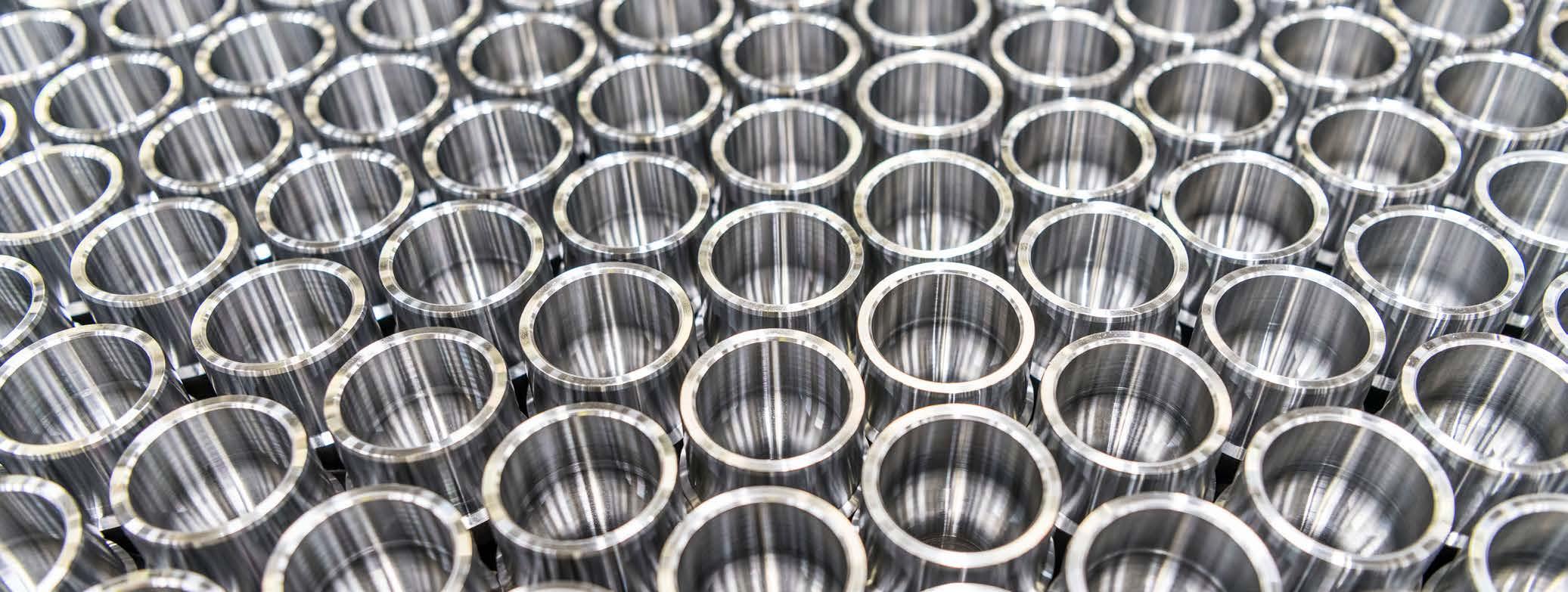
∣ We were pleased and proud to receive the Stora Leverantörspriset 2022 supplier award from the Scandinavian Association for Suppliers to the Automotive Industry FKG (Fordons kompo nentgruppen). This means our strong commitment to improving sustainability work in the metal industry and our initiative to share our experiences with our colleagues in the industry have been recognised and rewarded.
∣ Overall, 2022 was characterised by volume growth and improved results due to improved processes in many of our companies. This was particularly positive in view of the sharp rise in energy costs and materials price fluctuation. Orders received remained at a good level and we see no signs of a downturn. This means the outlook for the company in 2023 is favourable.
We were delighted to report an improved financial result in a year marked by huge challenges. Net sales increased by 23% to SEK 1,319 million and operating profit increased to SEK 51 million, up from SEK 43 million in the previous year.
Orders received were at a good level in the financial year, particularly in the second half of the year. We continued our efforts to broaden the customer base and in the financial year we successfully gained new medium-sized customers which operate in product areas that are new to us. The main challenges involved fluctuations in materials and energy prices and exchange rate fluctuations. The prices of raw materials and components rose in the first half of the year before stabilising and later falling, at the same time as our energy costs rose sharply. We managed the rise in costs through negotiations with our customers. The response was positive and the majority of our customers have been sympathetic to the price increases. We expect the adjustments in prices to have a positive effect on our performance for the full financial year 2023.
Our four machining production units performed well in 2022. We
were able to manage fluctuations relating to availability and cost of materials which were largely due to the war in Ukraine. The investments we have made in increasing capacity in recent years have meant that we have been able to meet growing demand from our customers in machining while maintaining high quality and delivery security.
In die casting we were satisfied with the performance of our production unit in Kulltorp and our tooling company UB Verktyg. At the same time, there were some challenges relating to efficiency at the unit in Unnaryd in the financial year. Orders received were at a particularly good level in the second half of the year, resulting in the launch of a package of measures. The measures are aimed at improving efficiency and lowering costs. Certain strategic organisational changes have been carried out and others will be implemented in 2023. We estimate that these improvements will have a positive impact on results in 2023.
As we look forward, we are able to identify several favourable trends. Relocation of production to the local area is continuing and secure supply chains, security and speed are becoming increasingly important competitive advantages. The war in Ukraine and its impact on the business climate has further reinforced this trend. Additionally, we estimate that electrification of the vehicle fleet will lead to significant opportunities for new business and new customers. Together with the work on expanding the customer base, these trends form the basis for our long-term strategic direction.
Other areas of strength are quality and sustainability, which are key areas for our customers. In October we received the Stora Leverantörspriset 2022 award from the Scandinavian Association for Suppliers to the Automotive Industry FKG (formerly Fordonskomponentgruppen), which we are very proud of. The award recognises our strong commitment to improving
sustainability work in the metal industry and our initiative to share our experiences with our colleagues in the industry.
I would like to thank our employees, customers and suppliers for the year just ended and look forward to successful collaboration in the coming year.
Halmstad, March 2023 Anders Magnusson CEO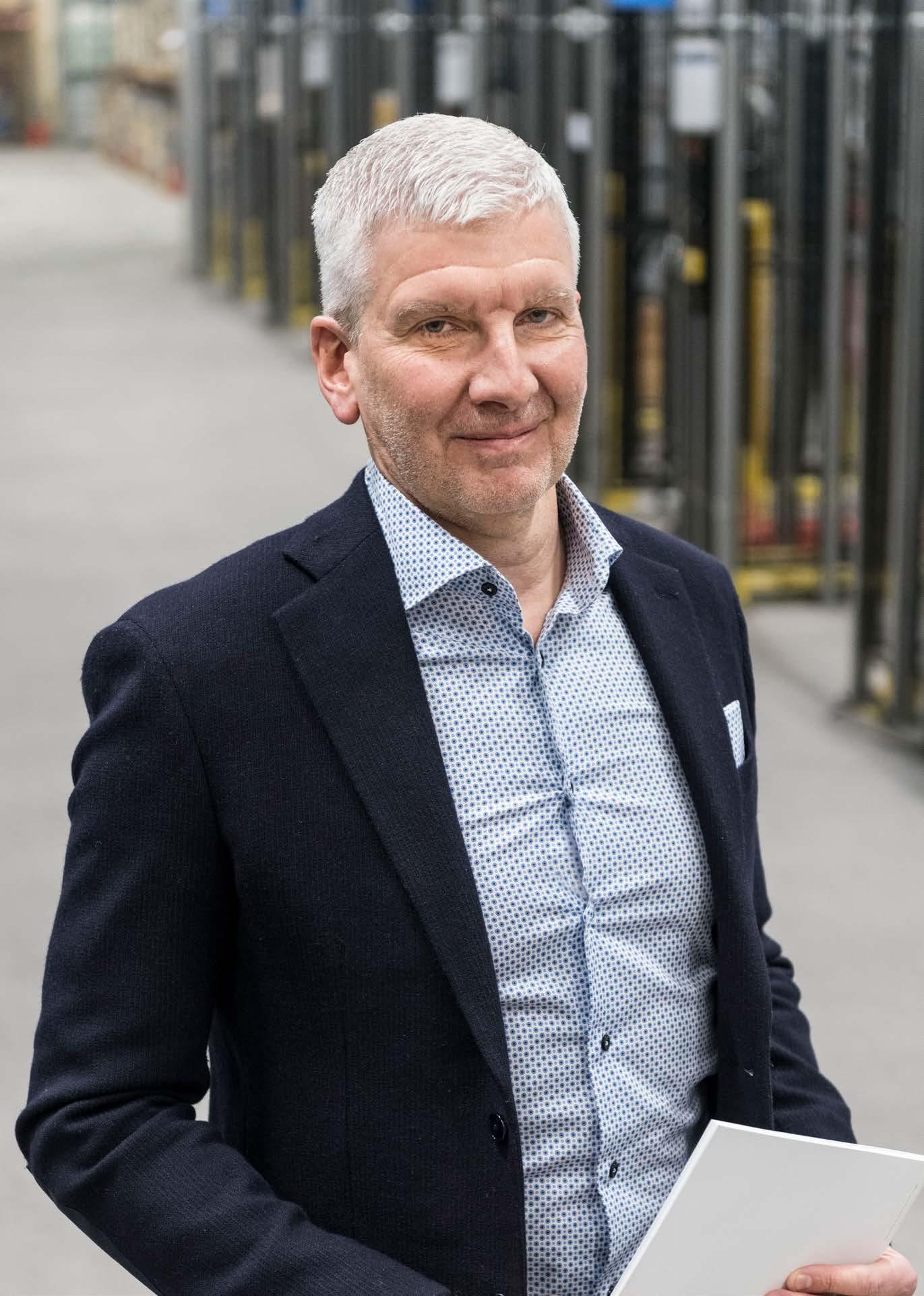
As we look forward, we are able to identify several favourable trends. Secure supply chains, security and speed are becoming increasingly important competitive advantages.
About the share
∣ AGES’ Class B shares are listed on Nasdaq Stockholm First North Premier Growth Market.
∣ The share capital amounts to SEK 35.1 million, divided between 1,822,200 Class A shares and 5,206,774 Class B shares. The quota value is SEK 5.
∣ Each Class A share carries 10 votes and each Class B share carries one vote. The total number of votes was 23,428,774.
∣ All shares have equal rights to dividends.
AGES shares are listed on Nasdaq Stockholm
First North Premier Growth Market. The highest closing price in 2022 was recorded on 11 July, when the price was SEK 64.80, while the lowest price, SEK 36.60, was recorded on 30 December. As at 31 December 2022, AGES’ market capitalisation was SEK 257 million, based on the closing price and total number of shares.
At the end of 2022, AGES had 1,229 shareholders. 1,183 of these were natural persons, of which 29 were resident abroad. The remaining 46 shareholders were legal entities, such as financial institutions, foundations and interest groups. The ten largest shareholders together controlled more than 95.7% of the votes and 85.7% of the capital.
The Board of Directors proposes that no dividend be paid for the financial year 2022. It is the aim of the Board of Directors that dividends should mirror financial performance over an extended period and correspond to at least 30% of profit after tax.
In 2021 AGES Annual General Meeting passed a resolution on a share incentive plan for group management, involving warrants for Class B shares. Of the 250,000 warrants that were issued, 230,000 have been subscribed for. The exercise price for the warrants is SEK 73.20. The exercise period runs from 15 May to 30 June 2024. If the subscribed warrants are exercised in full during the exercise period in 2024, it will result in share dilution of 3.17%.
ABG Sundal Collier acts as market maker for AGES on Nasdaq Stockholm First North Premier Growth Market. Their function is to promote good liquidity in the share and ensure a small spread between the bid and ask price in trading on the stock market. Eminova Fondkommission AB acts as Certified Advisor for AGES.
Share capital, new issues, etc. since 2013
4.85 Earnings per share
1,229 Shareholders 64% Share price in relation to equity

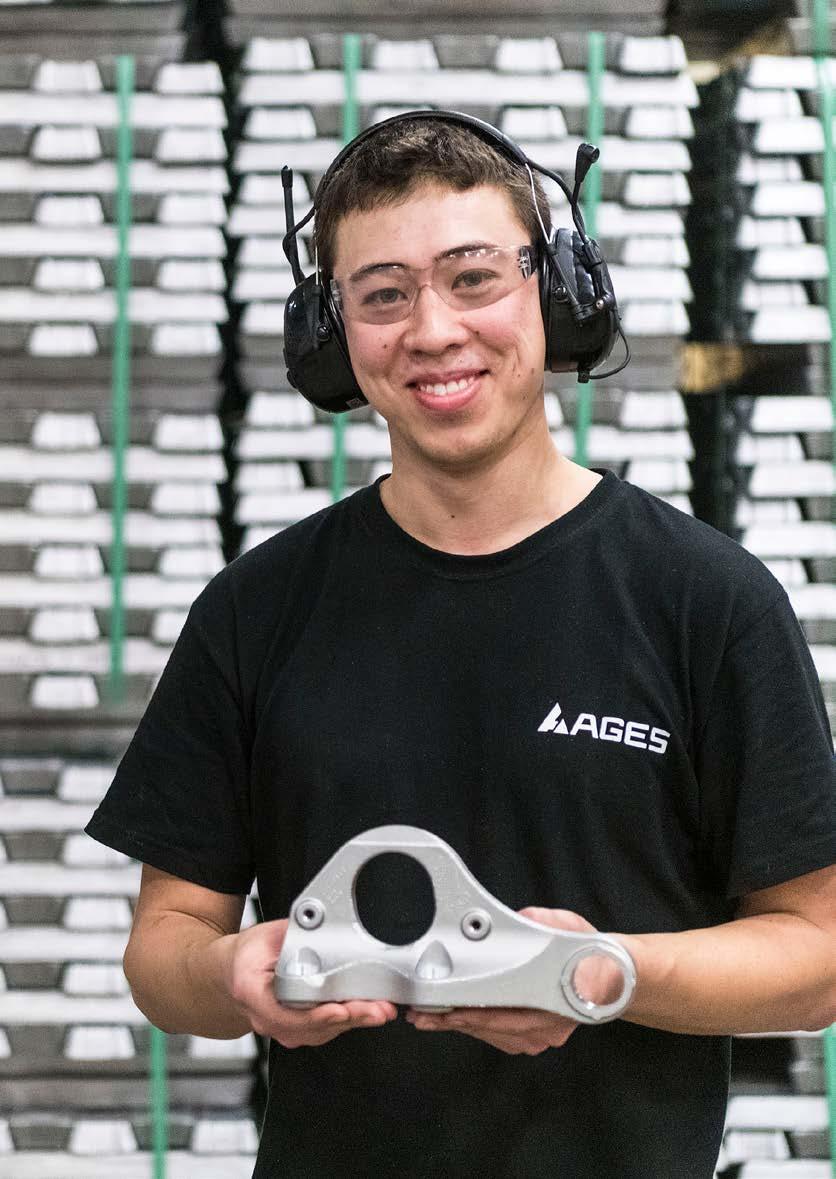

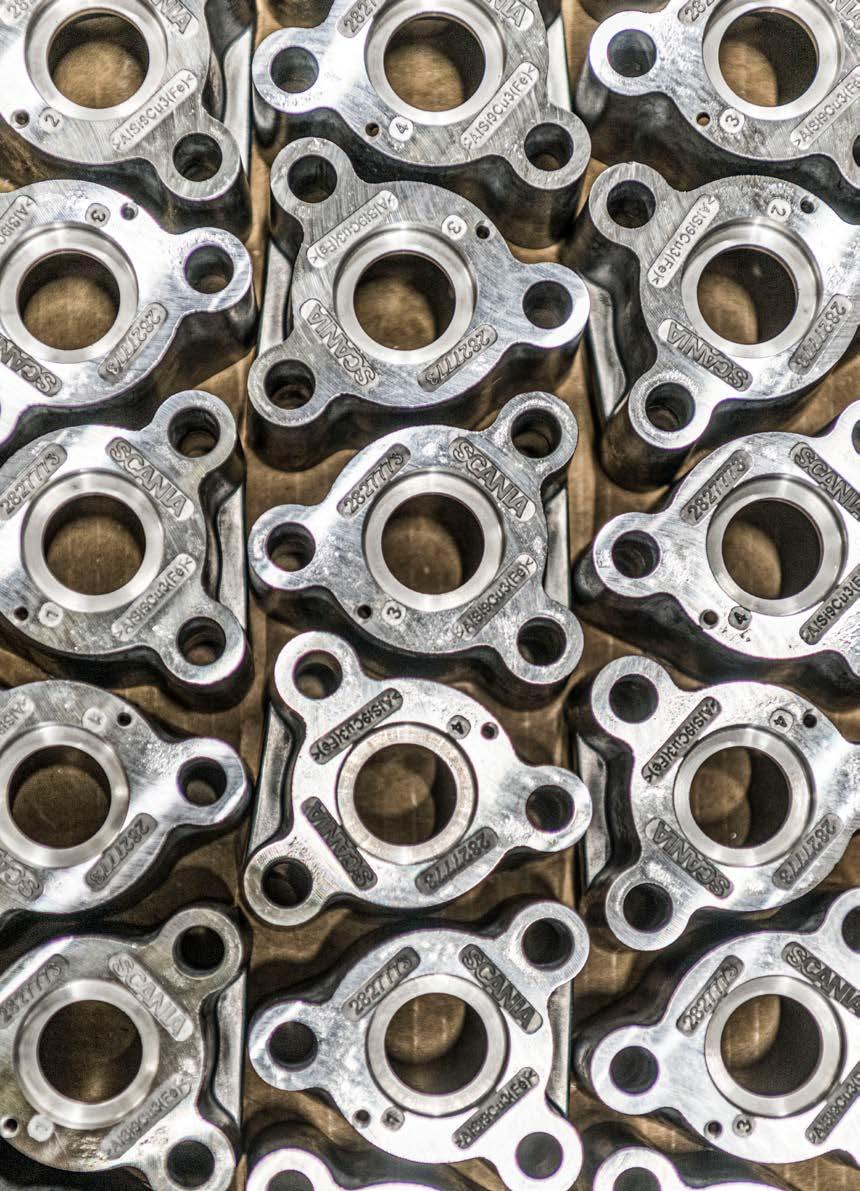
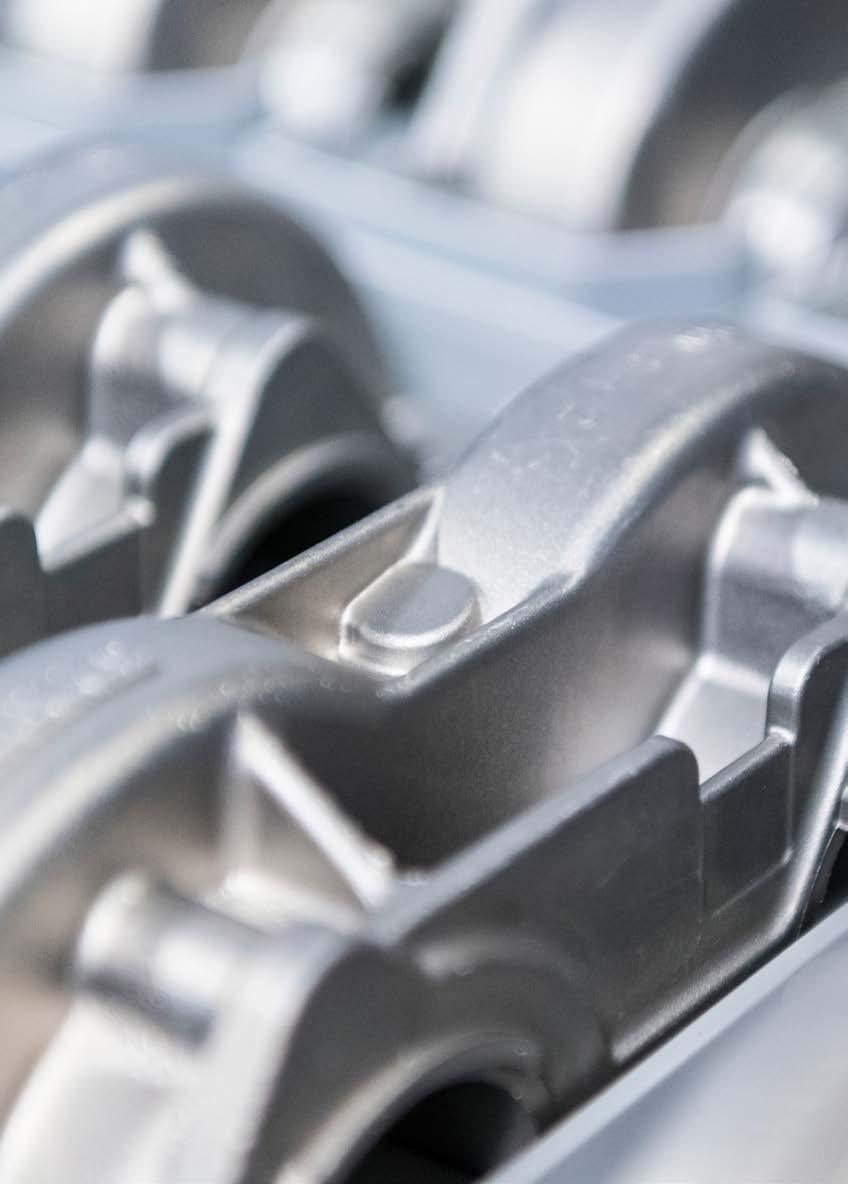
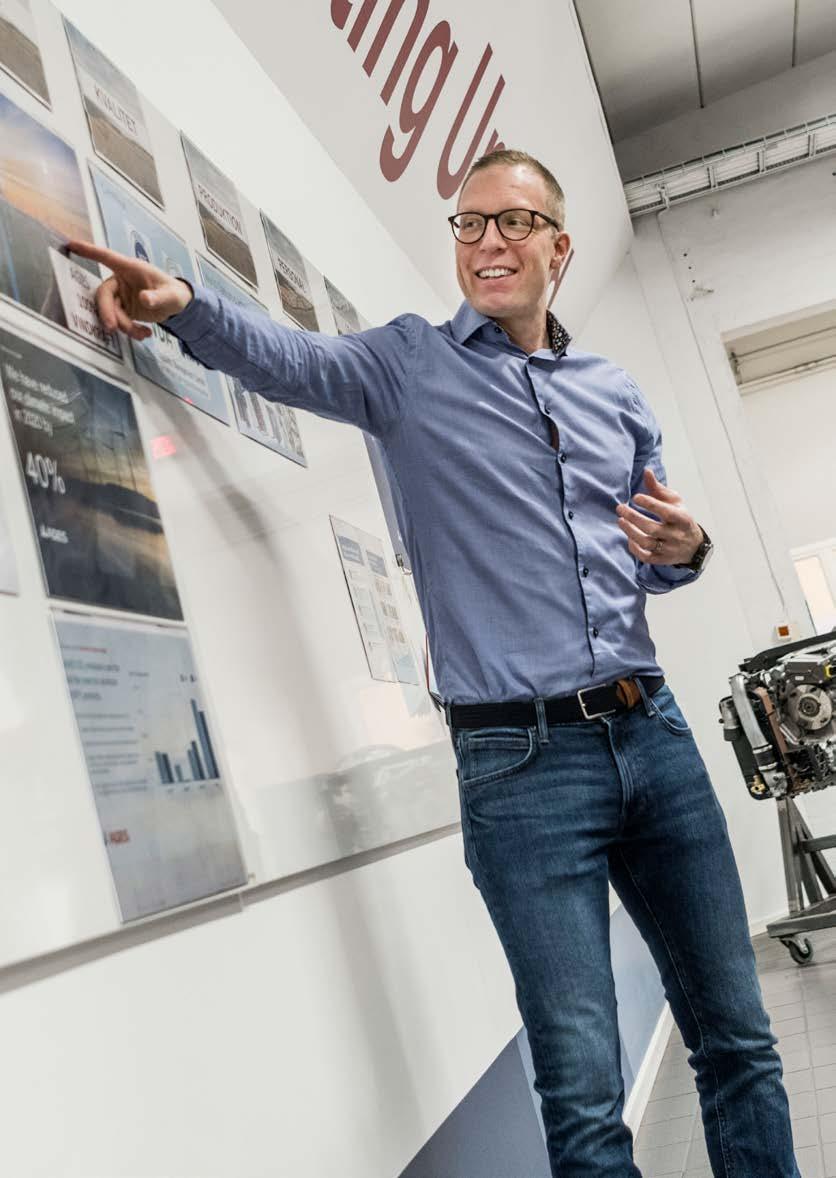

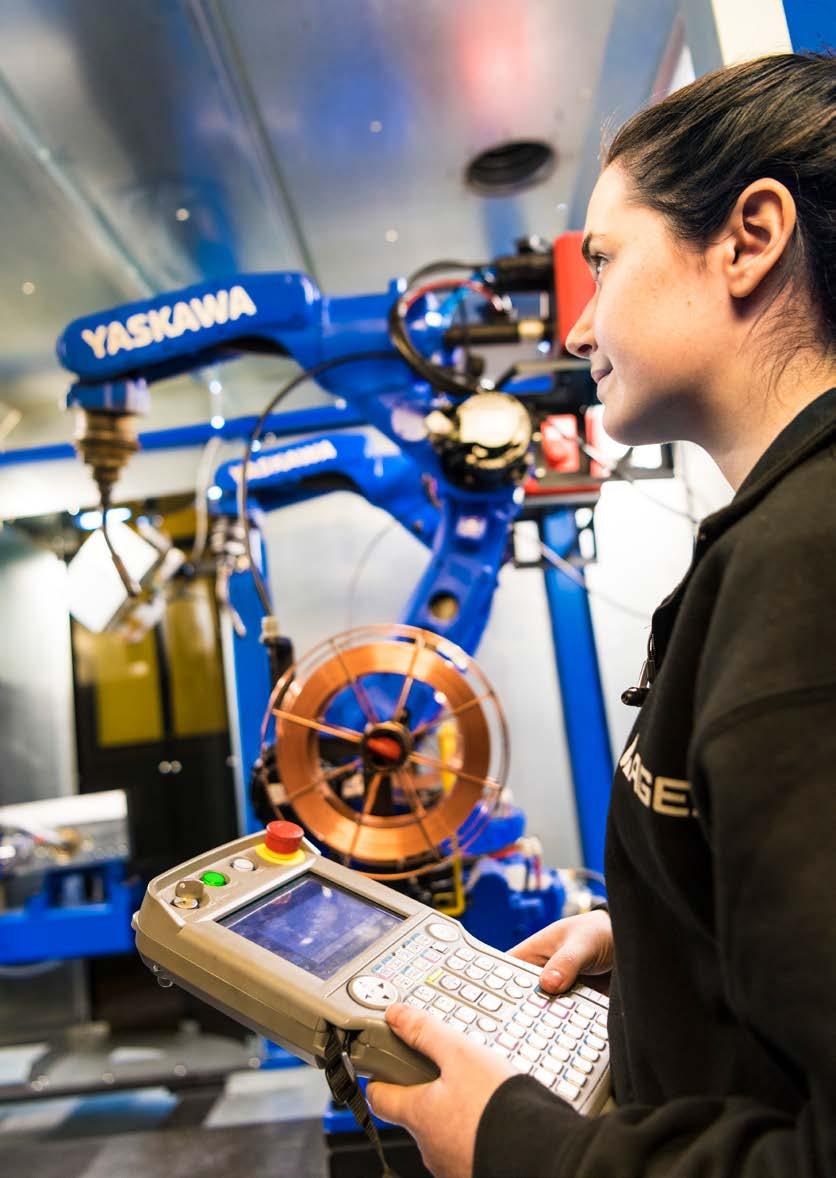
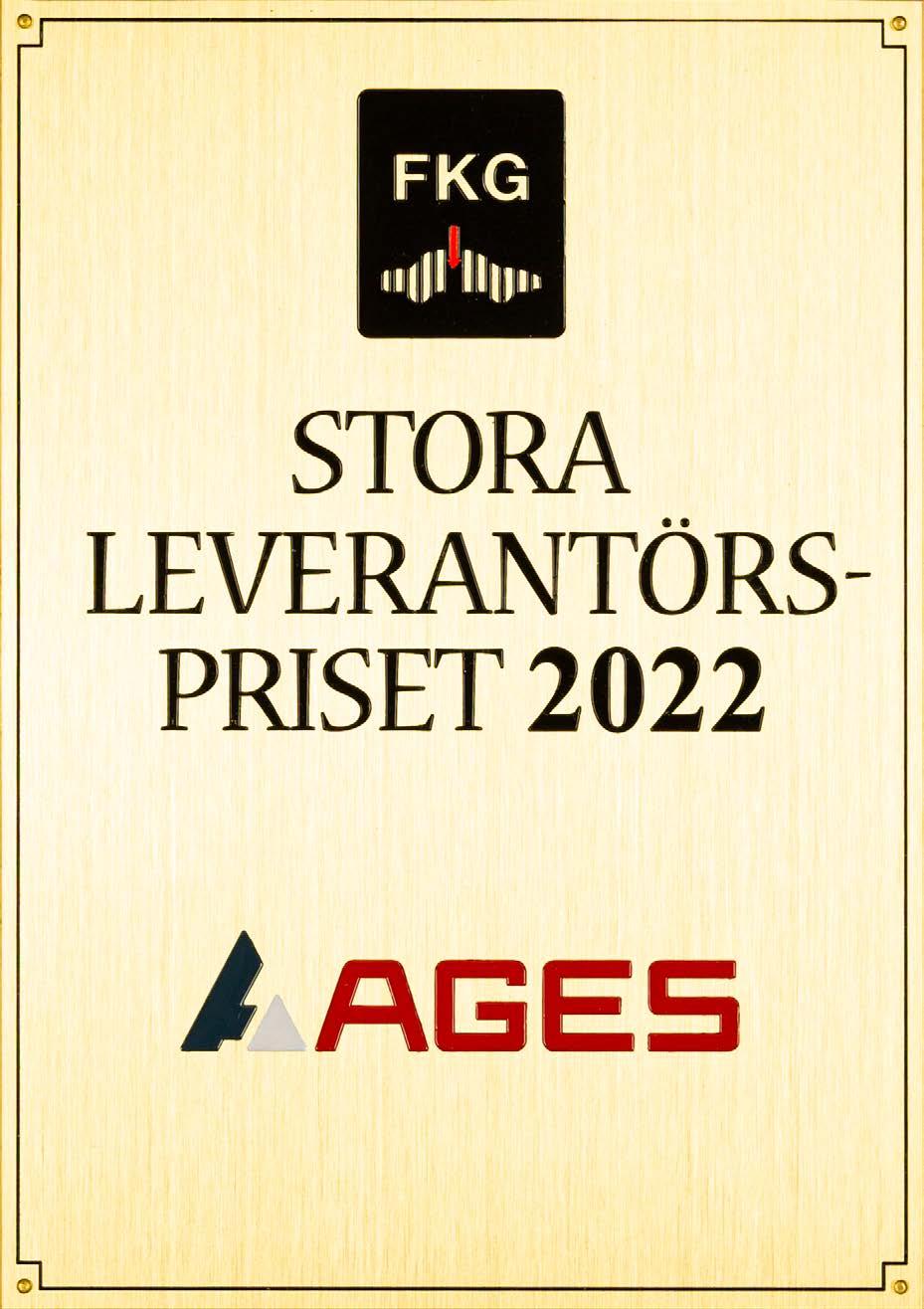
Our sustainability work involving mapping and reduction of CO 2 emissions was rewarded in the year as we received the Stora Leverantörspriset supplier award from FKG, The Scandinavian Automotive Supplier Association.

Stora Leverantörspriset award
AGES was praised by FKG, The Scandinavian Automotive Supplier Association, for taking sustainability work in the metal industry to a new level, and for generously sharing its work with other Swedish suppliers. Together with independent, external consultants we have carried out a review internally and in collaboration with our suppliers of control and mapping throughout the supply chain. We are now able to report CO 2 impact in kg per kg delivered castings. We were the first company on the market to report this metric. AGES is a forerunner in the work on carbon neutrality throughout the supply chain.
To facilitate active sustainability management, AGES’ sustainability reporting references the Global Reporting Initiative, GRI. This international and independent organisation has developed sustainability reporting standards that increase companies’ transparency. The aim is to help companies, governments and organisations to take action and make better decisions concerning issues related to climate change, human rights and corruption. GRI requires organisations to carry out a materiality assessment to identify their key sustainability issues.
The focus areas of our sustainability work were identified on the basis of a materiality assessment carried out in partnership with an external consultant in 2020. AGES’ sustainability strategy is to take an active approach to the work and highlight these focus areas.
See our website ages.se for the separate Sustainability Report for 2022.
“Sustainability and climate action are one of the key challenges of our times, not only in the automotive industry but for all of us, everywhere. AGES Industri AB, whose enthusiasm, willpower and driving force has shown that nothing is impossible, is a lodestar in this work. AGES has shown how, as a component supplier for steel and aluminium, it is possible to significantly reduce CO 2 emissions in just a few years. This is a competitive advantage that AGES is willingly sharing with others as part of its active efforts to share knowledge about how SME companies in our industry can make the same journey. Not only is the company one of the forerunners in sustainability in Sweden, but it is also actively working to ensure that other Swedish companies follow in its footsteps, making it a role model deserving of the Stora Leverantörspriset award.”
Our employees are fundamental to our success – this is why we consider it important to be an attractive employer. This is key to attracting, retaining and developing competence. In order to create a solid structure for competence development we work with the AGES Academy concept.

AGES Academy is fundamentally a platform for internal training in the Group – all employees should have an opportunity to develop and move forward in their career. It is also a culture-bearing forum that reinforces the sense of community and brings job satisfaction. We actively work to develop our values and stamp the AGES DNA on the organisation. This creates the conditions in which our employees can develop and thrive. All this enables us to create security for each other and our customers, collaboration partners and owners.
Being an AGES Ambassador is about living according to AGES values and putting them into practice. First and foremost this means focusing on our customers and delivering quality. It means delivering on time and according to agreed deadlines. Ambassadors also communicate the message that our work is meaningful and that together we create value.
All new employees are welcomed to AGES with the help of Bryggan (the Bridge). This is a method for a common way of working that promotes security, satisfaction and motivation. New employees are included in the preparations in good time before they start their employment. All units at AGES have a Dojo – a kind of “learning place”, where the same type of information is available to new employees. The process sets out AGES values in respect of both leadership and employeeship.
We want to harness the diversity of our employees and the different perspectives it offers to create opportunities for everyone to make their voice heard. This forms the basis for a positive corporate culture where everyone feels welcome. All views and contributions are equally valued. This is something that is highlighted by our AGES Ambassadors as one of the reasons they like working at AGES. Excellent opportunities to take initiative, drive improvement and develop are among the things often quoted in positive feedback from our employees. These are conditions that create engagement and drive us forward.

In AGES Shared Services we have recruited and gathered together pioneering competence in finance, HR and administration in order to be able to provide the best possible service to companies in the Group. We handle everything from payroll and invoicing to annual accounts and tax returns for the companies in the Group. Our objective is to offer our internal customers highly cost-effective and efficient processes and administrative solutions.
“Since our start in 2020 we have reaped significant rewards from collaboration,” said Jessica Dahlstedt, Site Manager and Controller at AGES Shared Services. “We have developed a shared vision of working methods and are able to work more efficiently. Our team is able to exchange views freely and learn a lot from each other and we have a great team spirit.”
When we gather our competence in one place we are in a better position to learn from each other. We can develop advanced, leading edge competence and harness specialist knowledge more efficiently. Our collective experience and different expertise complement and strengthen each other.
By developing collaborative working methods and procedures, we can share each other’s work load when necessary. When one of us is ill, a colleague can step in and help out. This provides a great sense of security for both our employees and the Group’s customers. More efficient working methods enable us to offer more cost-effective administrative solutions. Centralisation also makes it easy to scale up and manage more companies.
We have become more efficient and less vulnerable”
”
Jessica Dahlstedt, Site Manager/Controller AGES Shared Services

AGES’ offers large-series production of advanced precision components to leading players in selected customer segments. Driven production processes, an entrepreneurial spirit and cutting edge technological expertise create the conditions necessary to deliver the best solutions on the market while also ensuring cost-efficiency in production.
AGES wants to further develop the business concept in a way that supports sustained growth and profitability. AGES should be the market leader in its niche, in a historically stable market, and should be regarded by its customers, suppliers and employees as their most skilled, long-term cooperation partner.Ways to achieve this include good customer relationships characterised by a businesslike approach and close collaboration. AGES should build on its strong market position to actively seek to broaden its customer base. AGES should also be able to follow its customers outside the primary home market in order to expand the business.
AGES should create growth combined with profitability. AGES is aiming to achieve sales growth of at least 10% per year and should achieve a profit margin in excess of 8% over an economic cycle.
It is the aim of the Board of Directors that dividends should mirror financial performance over an extended period and correspond to at least 30% of profit after tax. However, the annual dividend ratio must be viewed in relation to investment needs.
AGES’ sustainability work is governed by the overarching goal to always keep improving the business in terms of the environment, working conditions and ethics. Our ambition is to reduce risks while simultaneously cutting costs and meeting the expectations of our stakeholders.
AGES should achieve established goals and market requirements through a strategic direction based on the following:
∣ Actively work to develop new customer areas outside the automotive industry.
∣ Continue to develop and grow AGES’ strong position in machining and welding of precision components.
∣ Retain AGES’ strong position in die casting in the Swedish market.
∣ Nurture and develop long-term business relationships with customers who require large-series production of cost-efficient precision components with high technological requirements, top quality and a high degree of accuracy in deliveries.

∣ Thanks to a high level of technology in production processes, large proportion of automation, committed employees and continuous improvements, create efficient and profitable, highly competitive production.
∣ Through proactive and long-term work and active participation in the supply chain, AGES seeks to be the industry leader both locally and globally in respect of mapping of CO 2 emissions.
The purpose of AGES’ concept is to make things easier for customers by providing a broad customer offering, a strong organisation and overall responsibility for turnkey solutions. Our high level of technological expertise and driven production processes enable us to provide high-quality products and services. We have worked to be an ever stronger onestop-shop for our customers, especially at a time when the need for flexibility and security is greater than ever.
Production and processing of die cast aluminium components and machining currently account for an equal percentage of sales. The AGES Group has eight production units. The operations, which include casting, processing, welding, tooling and assembly, focus on component manufacture.

The AGES companies in Unnaryd and Kulltorp specialise in die casting and associated processing. The AGES companies in Falkenberg, Värnamo and parts of AGES Hörle and AGES Ningbo specialise in machining. Assembly is performed by AGES Värnamo, AGES Unnaryd, AGES Hörle and AGES Ningbo.
UB Verktyg in Bor offers manufacturing of die-casting tools. Welding is concentrated in AGES Hörle. Processing in forging and casting takes place AGES Ningbo.
AGES Ningbo also operates in the domestic market in China.
Our strategic efforts to build and strengthen our organisation is a continuing process that enables us to address a broader customer segment. We have significant flexibility that enables us to manage several different component requirements for a single customer.
Shorter planning horizons and rapid changes in the external environment are challenges that we will have to live with for the foreseeable future. Thanks to rationalisation measures and a proactive approach to our work, we feel confident about the future.
Die casting
AGES specialises in die casting of aluminium and associated post processing.
Machining
AGES supplies components produced through machining of materials such as steel, stainless steel, brass and aluminium.

Welding
AGES performs robot welding and manual welding of advanced, highprecision products.
Tooling
AGES designs and manufactures quality tools for die casting of aluminium which meet stringent market requirements.
Assembly
AGES performs assembly in which the majority of the material used comprises self-produced components.
Projects and design
AGES is involved early on in the design phases of new projects. With more than 40 years of experience, high-tech plant and AGES’ expertise, we offer customers a quality-assured design process.
AGES designs and produces shaping tools that meet customers’ requirements for high-quality products. Through UB Verktyg, AGES controls the entire value chain and is therefore able to meet the market’s strict requirements regarding cost-efficiency and short lead times.
Product verification and outturn samples
AGES performs quality assurance and verification of new products in accordance with customers’ strict requirements. This ensures a high level of product quality during mass production.
Production
AGES’ production is customised and optimised for manufacture of large series of advanced components, with stringent requirements.
AGES takes a targeted approach to automation and investments in order to ensure foundries are industry leaders in their sector. High levels of automation guarantee robust processes and cost-effective manufacturing.
Post-processing
AGES die-cast products are completed by means of post-processing such as deburring, blasting, tumbling and cleaning before they are ready for delivery to customers or further refinement.
Supply and logistics
To meet customers’ requirements for precise deliveries, AGES uses the very latest solutions for EDI communication, KanBan, Pipechain and other just-in-time tools customised for customers’ systems.
Certificates
Quality management system:
ISO 9001
IATF 16949
Environment:
ISO 14001

AGES supplies components produced through machining of materials such as steel, stainless steel, brass, free-cutting steel and aluminium. Our operations are characterised by flexibility and outstanding technical expertise, with access to advanced production equipment guaranteeing precision, quality and efficiency. Robust knowledge of tools and materials allows us to offer a high level of service and custom solutions.
∣ turning and milling in CNC machines
∣ automated turning
∣ machining using rotary tables and automation
Projects and design
AGES has extensive experience of product development together with customers. AGES sees the big picture and identifies the parts played by each individual component, and optimises the design to ensure rational production and simplified assembly.
AGES performs quality assurance and verification of new products in accordance with customers’ strict requirements. This ensures a high level of product quality during later series production.
AGES’ production is optimised for large-series manufacture of advanced components. AGES has a large number of state-ofthe-art processing machines so that we can offer high levels of flexibility and process capability.
AGES takes a targeted approach to automation and investments in order to ensure foundries are industry leaders in their sector. High levels of automation guarantee robust processes and cost-effective manufacturing.
Many products processed by AGES undergo post-processing in the form of curing, grinding and painting. This is often the final process prior to delivery and requires guaranteed processes performed by qualified partners.
To meet customers’ requirements for precise deliveries, AGES uses the very latest solutions for EDI communication, KanBan, Pipechain and other just-in-time tools customised for customers’ systems.
Certificates
Quality management system: ISO 9001
IATF 16949
Environment: ISO 14001
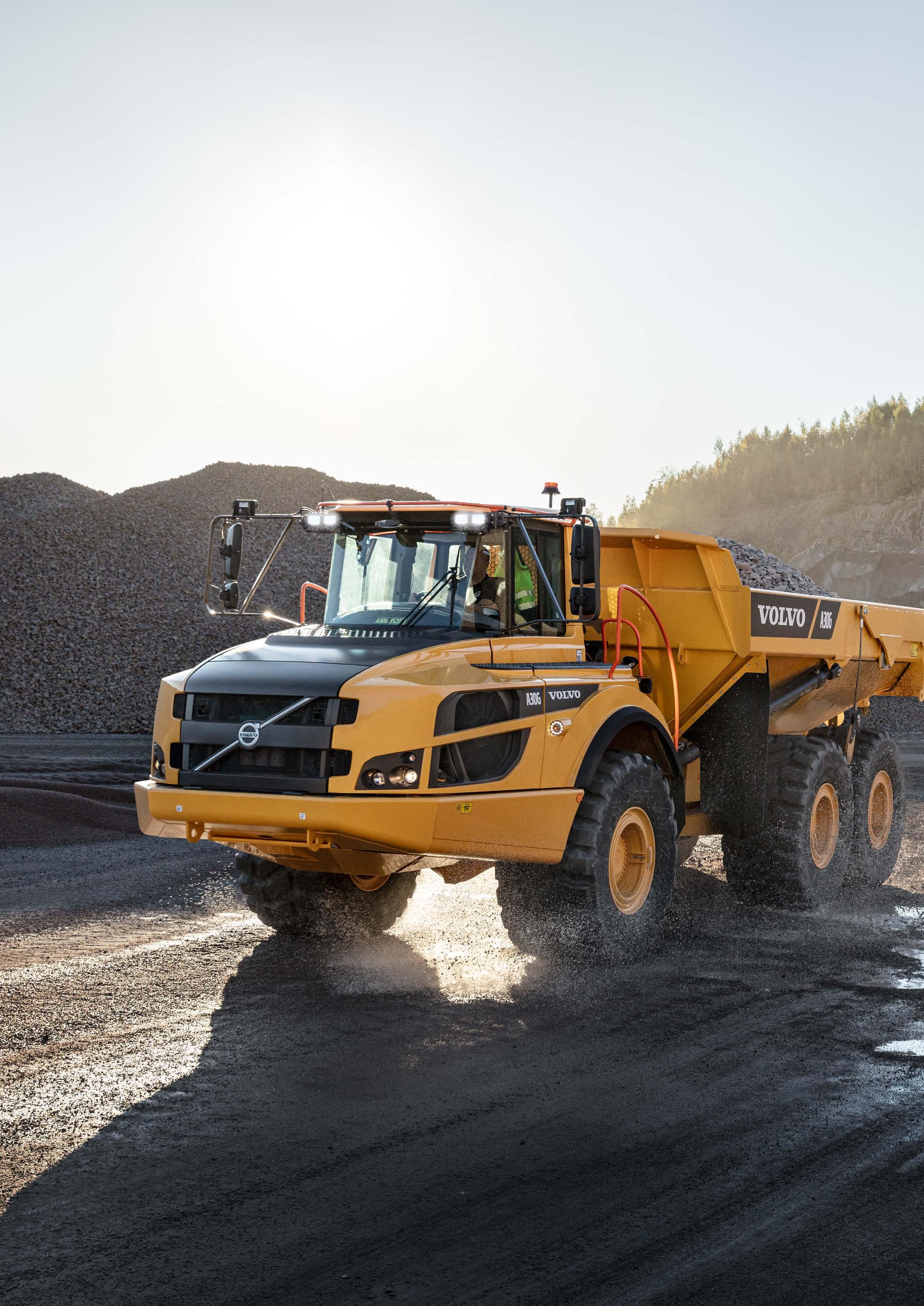
AGES performs robot welding and manual welding with maximum precision. The work is performed using state-of-the art equipment that meets strict environmental and technological requirements.
Before every new assignment we perform a technical review together with the customer in order to identify the optimum solution. Fixtures manufactured at our own workshop result in short lead times and guarantee that the products meet the specifications. AGES currently supplies a number of advanced items, including a number of safety-classified parts.
A well-developed and qualityassured process ensures project management where AGES contributes knowledge and expertise in both production technology and production economics.
Production of fixtures
AGES is responsible for the design and production of fixtures and other technological equipment. Much of product quality is controlled and ensured through the design of the production process layout.
Product verification and outturn samples
AGES performs quality assurance and verification of new products in accordance with customers’ strict requirements. This ensures a high level of product quality during later series production.
Quality assurance
AGES’ capacity for guaranteeing high product quality through production of fixtures is certified according to SS-EN ISO 3834-2.
Production
Production usually takes places in state-of-the-art robotic cells.
To ensure high, uniform quality, we use state-of-the-art Fronius technology for both manual and robot welding. The process is monitored and controlled by operators certified according to SS-EN ISO 14732 and SS-EN ISO 287-1.
Post-processing
AGES’ welded products are finished through post-processing such as grinding, machining, blasting and various surface treatments.
Supply and logistics
To meet customers’ requirements for precise deliveries, AGES uses the very latest solutions for EDI communication, KanBan, Pipechain and other just-in-time tools customised for customers’ systems.
Certificates
Quality management system: ISO 9001
IATF 16949
Environment: ISO 14001

Welding:
SS-EN ISO 3834-2
SS-EN ISO 14732
SS-EN ISO 287-1
AGES offers component and system assembly and testing in accordance with customers’ specific wishes.
Assembly and testing are carried out when the components have been manufactured – by means of die casting, welding or machining. The work is carried out using modern, efficient processes using the very latest technology.
AGES har extensive experience of projects and we use documented quality systems to ensure that supply and processes take place in accordance with the product specification.
Components
In assembly of complete systems, most of the incorporated components are from AGES’ own production. Purchased components that meet defined requirements via AGES’ systematic quality assurance are required to supplement these components.
Assembly
AGES has specialist facilities for assembly to be able to assemble both simple and advanced systems.
Automation
AGES takes a targeted approach to automation and investments in order to ensure foundries are industry leaders in their sector. High levels of automation guarantee robust processes and cost-effective assembly.
Product verification and inspection
AGES performs quality assurance and verification of assembled systems by means of final testing and other tests using measurement tools and measurement machines offering cutting-edge technology. This guarantees high product quality.
To meet customers’ requirements for precise deliveries, AGES uses the very latest solutions for EDI communication, KanBan, Pipechain and other just-in-time tools customised for customers’ systems.
Certificates
Quality management system:
ISO 9001
IATF 16949
Environment: ISO 14001

AGES manufactures quality tools for die casting of aluminium. Our tools are designed to meet the market’s strict requirements for firstclass products, short lead times and cost-efficiency throughout the process chain. The earlier in the process that we become involved, the more the tools can be customised for an optimal end-result.
Our modern machinery is used to produce the components for the casting tool in our own production. Our expertise and understanding of the customer’s needs enable us to design tools that result in efficient production at the customer.
AGES enters the process at an early stage and participates in the development of 3D models to be able to develop a tool that ensures optimised, time-sensitive and costeffective production at the customer. We start by analysing the details of production and make suggestions for improvements in order to detect and eliminate weaknesses at an early stage.
Design of casting tools
AGES performs various simulations and sustainability calculations in order to be able to design the best possible options. We are therefore able to ensure the best possible component quality already at the design stage. Casting simulation replaces expensive attempts to produce optimum casting technology.
Production of casting tools
AGES manufactures the parts for the casting tool in its own production, giving the company full control over all incorporated parts, delivery times, etc, resulting in a durable, high-quality casting tool.
Following trial casting at the customer, the part is measured and adjusted as necessary. Validation and quality assurance are a natural part of the process at AGES.
AGES offers rapid support for any changes to existing casting tools, including spare parts, maintenance and service, to meet our customers’ high expectations.
Certificates
Quality management system: ISO 9001
Environment: ISO 14001

AGES has a strong position in Sweden and is one of the leading operators in Scandinavia in production of precision components. We consider Northern Europe to be a strategically important growth market but we also have several global customer relationships. Our marketing aims to both further develop existing customer relationships and further expand our customer base. To meet growing demand for flexibility, delivery security and quality we actively focus on being close to our customers. Customer confidence and trust, stability and reliable quality are important to us.
The transition towards electrification is continuing to drive development in the automotive segment, which suggests the market for components made from aluminum and high-quality steel will continue to grow. This transition will change the industry and create opportunities for new customers and new deals.
Relocation of production to the local area is continuing and secure supply chains, security and speed are becoming increasingly important competitive advantages. Our existing production units are efficient and skills exchange within the Group gives us maximum flexbility.
Increased electricity and energy costs, as well as shortages of raw materials and semiconductor components are a challenge for the industry. Many things point to continued instability and rapid changes in the coming year.
We are adhering to our strategy of broadening the customer base, rationalising production and safeguarding our logistics and supply chain.
Quality and sustainability are key issues for us and we are also finding that these are becoming increasingly important to our customers. The debate concerning carbon dioxide emissions is continuing and we are convinced that mapping and pricing of CO 2 emissions will be required throughout the manufacturing supply chain.
Sustainability reporting requirements are becoming more stringent. Historically, the industry has not been able to fully agree which parts of the supply chain should be included in the calculations of CO 2 emissions. We believe it is important to take the entire chain into consideration, which means our customers are required to include calculations of both AGES’ and our suppliers’ climate impact. We take a proactive approach and report
CO 2 emissions per delivered component for a large proportion of our products. This is a clear sales argument in respect of our customers and shows our commitment to these issues.
Fundamentally, the market is based on strong demand. However, demand may be impacted by economic factors, such as a recession.
Availability of input materials has stabilised. The cost of compensating for energy costs is an added factor with regard to input materials. Logistics and security are becoming increasingly important. For this reason, we have focused on moving production closer to end customers. This ensures we are well prepared for the future and for meeting customer requirements. We are

52% 16% 11% 6% 5% 4% 3% 1% 2%
Heavy vehicle industry
Material handling
Light vehicle industry
Industry
Marine Medical technology Other
AGES’ sustainability work is governed by the overarching goal to always keep improving the business in terms of the environment, working conditions and ethics. Our prioritised focus areas are based on continuous dialogue with customers, employees, authorities, local organisations and other stakeholders. Our ambition is to reduce risks while simultaneously cutting costs and meeting the expectations of our stakeholders.
Our business is built by committed employees who act responsibly to meet the expectations and wishes of our external environment. An important aspect of the work is to look at AGES’ role in the overall processing chain from our customers’ perspective, and consider how we can contribute efficient processes that offer added value. In addition to customers and employees, our most important stakeholders also include owners, suppliers and permitissuing authorities. Our focus areas together cover all three sustainability perspectives: environment, social and economic.
In recent years, AGES has focused intensely on mapping and reduction of CO 2 emissions. We use 100% recycled aluminium in our casting plants. In 2022, this enabled us to avoid carbon dioxide emissions of 56,810 tonnes, compared with the same production based on primary aluminium. We have been able to reduce our CO 2 impact in die casting by 37%. In machining our goal is to increase the proportion of scrap steel to 35% by 2025.
We are actively working to be an attractive employer, to be able to recruit and retain skilled employees. Our employees are offered continuous competence development. As an employer, we also want to encourage diversity among our employees and create positive corporate culture where everyone feels welcome.
By being a strong and viable company we can continue to invest in sustainable solutions and develop processes for increased sustainability in respect of all sustainability aspects, and also ensure continued competitiveness.
AGES takes a strategic approach to sustainability work in five focus areas

Create opportunities for skills development, recruitment and employee retention
Ensure stable economic performance and long-term profitability
Reduction of operational GHG emissions
Create a safe, secure and healthy workplace
Ensure high product quality
The UN Global Goals are an ambitious agenda for sustainable development by 2030, comprising 17 overarching goals subdivided into different targets.
The sustainability perspective is an integral part of our day-to-day operations and goes hand in hand with our business strategies. As part of our sustainability strategy, AGES’ sustainability reporting now references the Global Reporting Initiative (GRI), Universal Standards 2021.
GRI is an international, independent organisation that helps companies, governments and organisations create transparency around the effects of issues relating to climate change, human rights and corruption. They have developed sustainability reporting standards that increase the transparency of organisations. A materiality assessment to identify key sustainability issues must be carried out. The assessment enables organisations to make decisions that produce economic, environmental and social benefits.
In future, AGES will continue to take a strategic approach to sustainability by updating our existing sustainability strategy to include economic, environmental and social sustainability in line with our focus areas. These were identified on the basis of a materiality assessment carried out in partnership with an external consultant in 2020. We will be setting new goals based on the updated sustainability strategy and preparing action plans supporting these goals. Together with independent, external consultants we have developed a structure and strategy for the sustainability report.
With effect from the financial year 2025, AGES will be covered by the new EU reporting legislation CSRD (Corporate Sustainability Reporting Directive). This means that our sustainability reporting will be further developed to meet the EU’s European Sustainability Reporting Standards (ESRS) and include reporting in accordance with the EU Taxonomy with effect from that year.
AGES has also carried out mapping of our sustainability impact in respect of the UN Global Goals (SDGs, Sustainable Development Goals) by examining our respective goals chosen from the full list of 168 targets. The goals are linked to our material sustainability aspects and are narrowed down to areas in which AGES is able to measure and monitor our performance.
See our website ages.se for the separate Sustainability Report for 2022. On the website we provide more detailed information about our sustainability work, prepared in accordance with Global Reporting Initiative (GRI) Universal Standards. For example, we report the specific targets we are focusing on in respect of the Global Goals.


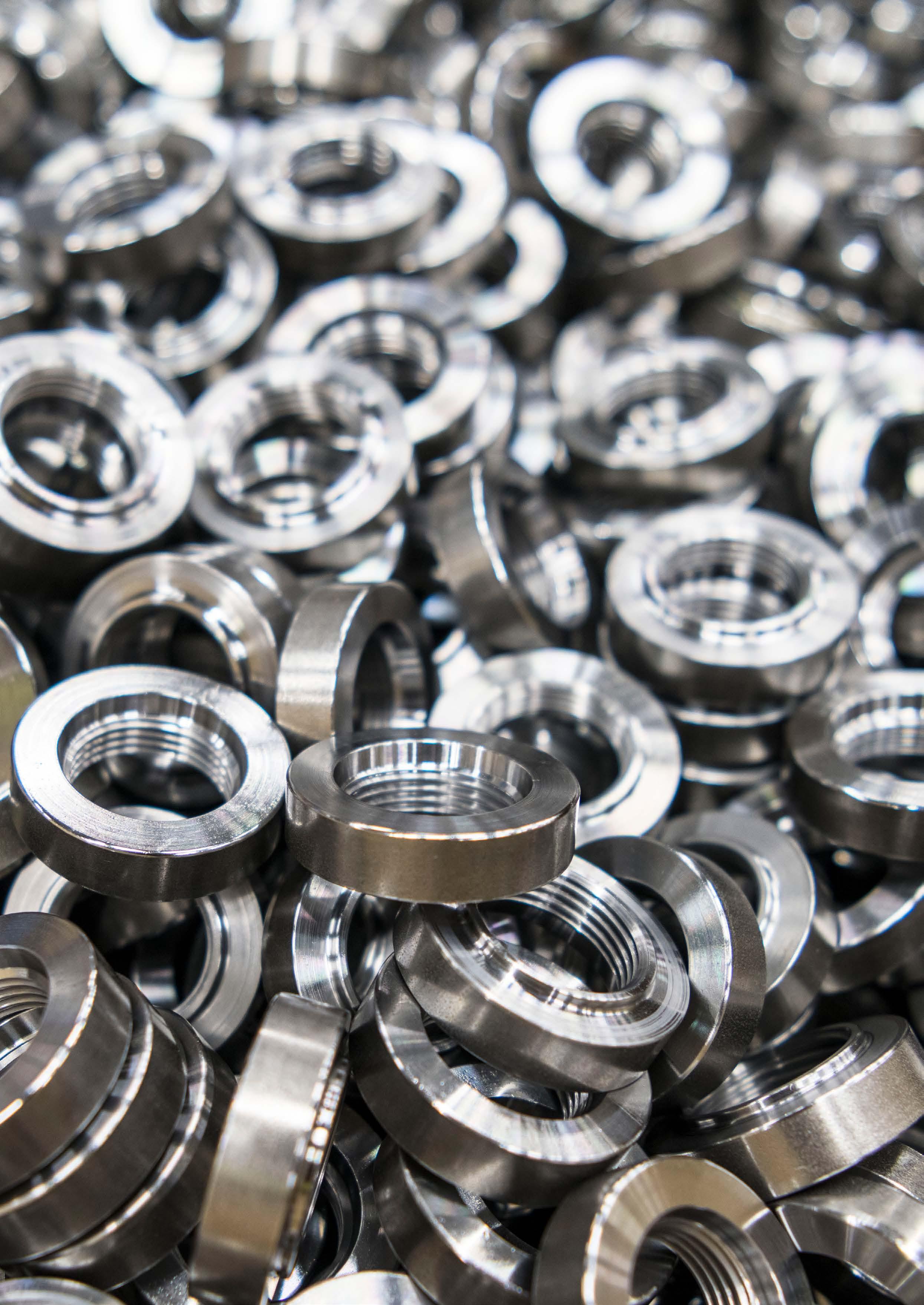
The Board of Directors and CEO of AGES Industri AB (publ), corporate identity number 556234-6204, domiciled in Halmstad, Sweden, hereby submit their Annual Report and consolidated financial statements for the financial year 2022.
AGES’ operations primarily comprise die casting, machining, welding, assembly and tooling. Production is concentrated on high-volume component manufacturing, with a high proportion of sales to customers in the automotive and engineering industries. Driven production processes, an entrepreneurial spirit and cutting edge technological expertise create the conditions necessary to deliver the best solutions on the market while also ensuring cost-efficiency in production. The Group comprises eight manufacturing units with operations in Sweden and China.
AGES’ Class B shares are listed on Nasdaq Stockholm First North Premier Growth Market under the symbol AGES B and the company’s Certified Advisor is Eminova Fondkommission AB.
Net sales totalled SEK 1,319 million (1,070), an increase of around 23% compared with the previous year. Profit after tax amounted to SEK 34 million (26), an increase of around 31% compared with the previous year.
Earnings per share amounted to SEK 4.85 (3.65). Equity per share amounted to SEK 57.00 (52.00). The total number of outstanding shares was 7,028,974. The equity/assets ratio was 41% (37).
The number of full-time employees in the Group as at 31 Decem-
Net sales (SEK million)
ber 2022 was 544 (524). The average number of employees was 482 (491). For more information about employees, see Note 4.
2022 was a positive year despite many major challenges, such as the Ukraine conflict, inflation and energy crisis. Rising prices of raw materials and energy resulted in comprehensive negotiations with customers regarding price increases. The outcome of the negotiations was positive.
Orders received were at a good level in the financial year, particularly in the second half of the year. Efforts to broaden the customer base continued and the customer base has been expanded to include customers in new product areas. Increased cooperation between the various production units means that we are able to offer our customers complete solutions to a greater extent than before.
The die casting unit in Unnaryd had some challenges relating to production efficiency in 2022, as a result of which a package of measures was introduced which will be implemented in 2023. The measures will focus on improving production efficiency and lowering costs.
Our machining operations implemented a number of investments in machinery, primarily in order to meet increased demand but also to improve the efficiency of production processes.
AGES’ sustainability work bore fruit in the year, with the Group receiving the Stora Leverantörspriset 2022 supplier award from the Scandinavian Association for Suppliers to the Automotive
1,319 51
Industry (FKG). The Group will continue to develop its sustainability work in 2023 to meet both customer requirements and future regulatory requirements.
The underlying work on marketing is continuing, and we are pursuing our long-term, strategic plan aimed at shifting the focus from production to marketing and expertise. We are also pursuing our strategies to develop other customer segments. Electrification of the vehicle fleet is expected to create opportunities for new business and customers.
Secure supply chains, security and speed are becoming increasingly important competitive advantages, which is why we believe relocating production closer to home is positive for our business.
We have also noted an ever growing interest in sustainability issues. AGES is well placed to discuss various solutions that lead to reduced environmental impact for us and for our customers.
There were no significant events after the reporting date.
The Group’s net investments in non-current assets amounted to SEK 54 million (66), of which SEK 1 million (1) comprised investment in property and SEK 52 million (65) investments in machinery and equipment. The remaining SEK 0 million (0) comprised business combinations.
Cash flow from operating activities amounted to SEK 103 million (-22). The Group’s cash and cash equivalents, including committed but undrawn credit lines, stood at SEK 45 million (21) at the balance sheet date.
The improvement in cash flow was partly due to one of our units joining the supply finance programme of a major customer in the first quarter. The aim of the programme is to shorten lead times between invoicing and payment.
The short-term shareholder loan of SEK 30 million accepted in the third quarter of 2021 was paid back in full in the third quarter, in accordance with the repayment plan.
The Group’s principal risks and uncertainties included business risks associated with customers and suppliers and other external factors such as price risks involving input goods. In addition, there are financial risks as a result of changes in exchange rates and interest rates. See Note 31 for a description of the Group’s principal financial and business risks.
AGES has some sales and purchasing in foreign currencies and is primarily exposed to foreign exchange rate changes in EUR, CNY and USD against SEK. The Group’s interest-bearing liabilities as at the balance sheet date amounted to SEK 290 million (335). A description of the Group’s financial risks can be found in Note 31.
AGES’ Sustainability Report is prepared separately from the Directors’ Report and is available on the company’s website www.ages.se.
The Group carries out notifiable activities pursuant to the Swedish Environmental Code in one Swedish subsidiary and activities requiring a permit in seven Swedish subsidiaries. The Parent Company does not have any notifiable activities. All of the production units are certified according to the environmental management system ISO 14001. AGES’ production units are all certified according to the ISO 9001 quality management system and a number of units are also certified according to the automotive industry standard IATF 16949 and VDA.
The Group does not carry out any product research and development activities itself.
AGES’ Class B shares are listed on Nasdaq Stockholm First North Premier Growth Market. The company’s Class A shares are not listed. The share capital amounts to SEK 35.1 million. The quota value is SEK 5. The total number of shares as at the balance sheet date stood at 7,028,974, distributed between 1,822,200 class A shares and 5,206,774 class B shares. One Class A share carries 10 votes per share and one Class B share carries one vote.
All shares have equal rights to the company’s assets and dividends. At the end of 2022, AGES had 1,229 (1,245) shareholders. The company currently has two shareholders who each own and control more than 10% of the voting rights of all the shares in the company. Anna Benjamin and her companies control 28.8% of the shares and 57.9% of the votes. Pomona-gruppen AB holds 29.9% of the shares and 29.7% of the votes.
The company has a current share incentive programme
(“Warrants 2021/2024”), under which 230,000 warrants were issued in 2021. The warrants may be exercised in the period 15 May 2024 to 30 June 2024. The exercise price for the warrants corresponds to SEK 73.20. The dilution effect is estimated to be around 3.17%.
AGES’ Board of Directors consists of five ordinary members. The Board members elected by the meeting of shareholders include representatives of AGES’ major shareholders as well as persons independent of the major shareholders. The CEO and other executives in the Group participate in the meetings of the Board of Directors for presentations or in an administrative capacity. The Board of Directors held seven meetings in the financial year. The agenda for each ordinary meeting includes regular reporting items and decisions, as well as information on the business, in accordance with the Board of Directors’ rules of procedure. The Board of Directors also decides on issues of an overarching nature, such as the Group’s strategy, structural and organisational matters. as well as major investments. One of the company’s auditors participates in at least one Board meeting per year. The auditor’s observations arising from the audit of the company’s accounts, procedures and internal controls are presented at this meeting.
The 2022 Annual General Meeting appointed a Nomination Committee comprising Ulf Hedlundh as the Chairman, Anna Benjamin and Per Rodert. The task of the Nomination Committee prior to the 2023 Annual General Meeting is to propose the Chairman of the Board of Directors and other Board members, auditors, a chairman for the AGM and fees for the Board of Directors, committees and auditors. Prior to the 2023 Annual General Meeting, the Nomination Committee has so far held one ordinary meeting and also conducted numerous discussions between the Nomination Committee's members. The Articles of Association do not contain any separate regulations on the appointment and removal of Board members.
For definitions and alternative performance measures, see Note 32.
1) Profit/loss for 2019 was impacted by goodwill impairment of SEK -150.5 million.
Profit/loss for 2018 was adversely affected by costs of SEK -7.6 million relating to reorganisation of group management.
AGES’ corporate governance is based on Swedish legislation and the listing agreement with Nasdaq Stockholm. Directives issued by authorities and stakeholders in Swedish industry and in the financial markets are also applied in various matters. Governance, management and control is shared between the shareholders at the Annual General Meeting, the Board of Directors and the CEO in accordance with the Swedish Companies Act and the Company’s Articles of Association and rules of procedure.
It is recommended that companies listed on Nasdaq Stockholm First North Premier Growth Market adhere to the Swedish Corporate Governance Code (“the Code”). AGES’ Corporate Governance Report is prepared separately from the Directors’ Report and can be found on pages 78-80.

AGES’ Board of Directors proposes that the Annual General Meeting renew the Board’s authorisation to decide on a new issue of Class B shares corresponding to a maximum of one tenth of the company’s issued shares. Such a mandate would enable the Board to make a decision on a new issue in the period until the next Annual General Meeting. The terms and conditions of the issue, including the issue price, must be based on a valuation on market terms, with the issue price at any given time set as close to the market value as possible, less the discount which may be necessary to generate interest in subscription.
Guidelines regarding remuneration of senior executives can be found in Note 4.
No major changes are proposed ahead of the 2023 Annual General Meeting.
The Board of Directors and the CEO propose that these funds be appropriated as follows:
The Board of Directors proposes that no dividend be paid for the financial year 2022.

(All amounts are reported in SEK thousand, unless otherwise stated.)
The company AGES Industri AB (publ), corporate identity number 556234-6204, carries on business activities as a limited company and its registered office is in Halmstad municipality in Sweden. The address of the head office is PO Box 815, SE-301 18 Halmstad. All amounts are reported in SEK thousand, unless otherwise stated.
The annual accounts have been prepared in accordance with International Financial Reporting Standards (IFRS), as adopted by the EU, the Swedish Annual Accounts Act and recommendations and statements by the Swedish Financial Reporting Board.
The applied accounting policies and measurement bases are unchanged compared with the previous year, with the exception of new or revised standards, interpretations and improvements effective for periods beginning on or after 1 January 2022. These updates have not had any material impact on the consolidated accounts. New or revised IFRS standards effective in 2023 and beyond have not been applied to the preparation of these financial statements. Application of these updates is not estimated to have had any material impact on the Group’s financial performance and position.
The nature and scope of related party transactions is set out in Note 34 to the financial statements.
The consolidated financial statements have been prepared in accordance with International Financial Reporting Standards (IFRS). Because the Parent Company is a company domiciled in the EU, only IFRS adopted by the EU have been applied. In addition, the consolidated financial statements were prepared in accordance with Swedish legislation through application of the Swedish Financial Reporting Board’s Recommendation RFR 1 Supplementary accounting rules for groups. The consolidated accounts include the Parent Company, AGES Industri AB, and the companies in which the Parent Company had a direct or indirect controlling interest on the balance sheet date. A company has control over another entity when it is exposed to, or has rights to, variable returns from its involvement with the company and has the ability to affect those returns through its power over the entity. This is usually achieved if the holding corresponds to more than 50% of the votes. The consolidated accounts have been prepared in accordance with the acquisition method. This means that instead of investments in subsidiaries, in the consolidated financial statements the subsidiaries’ identifiable assets, liabilities and contingent liabilities are measured at fair value at the time of acquisition. The equity of the acquired subsidiary is eliminated in its entirety, which means that the consolidated equity includes only that portion of the subsidiary’s equity which has accrued after the acquisition. If the consolidated acquisition value of the shares exceeds the value of the company’s net assets in the acquisition analysis, the difference is recognised as consolidated goodwill. If the consolidated acquisition value of the shares is instead lower than the value of the company’s net assets, the difference is recognised directly through profit or loss for the year.
All intra-group deals, revenue, expenses, gains or losses that arise through transactions between companies which are included in the consolidated financial statements are eliminated in their entirety. Only results that arise after the time of acquisition are included in the consolidated results. The results of companies that have been sold are recognised until the time of the disposal.
Business combinations
IFRS 3 is applied to business combinations, which among other things means that acquisition-related transaction costs are accounted for as expenses.
Items included in the financial statements of the various entities belonging to the Group are measured in the currency used in the primary economic environment in which each company operates. The Swedish krona (SEK), which is the Parent Company’s functional and presentation currency, is used in the consolidated financial statements. The subsidiaries use the local currency in their respective countries as their presentation currency and this has been regarded as the functional currency. Transactions in foreign currency are translated into the functional currency at the exchange rates prevailing on the transaction date. Exchange gains and losses arising in connection with such transactions and in connection with remeasurement of monetary assets and liabilities in foreign currency at the exchange rate on the balance sheet date are recognised through profit or loss for the year. The results and financial position of all Group companies are translated to the Group’s presentation currency as follows:
– assets and liabilities are translated at the exchange rate on the balance sheet date, – income and expenses are translated at the average exchange rate during the financial year,
– exchange differences arising in connection with translation of foreign operations are recognised as translation differences through other comprehensive income.
In order for the Group to be able to recognise revenue from contracts with customers, each contract is evaluated according to the standard’s five-step model:
1. Identifying a contract between at least two parties which involves a right and an obligation.
2. Identifying the various obligations.
3. Determining the transaction price, that is, the amount of consideration that the company is expected to receive in return for the promised goods or services. The transaction price must be adjusted for variable elements, for instance any discounts.
4. Allocating the transaction price to the various performance obligations.
5. Recognising revenue when the performance obligations have been satisfied, that is, control has been transferred to the customer. Control is transferred at a point in time or over time if any of the criteria detailed in the standard are met.
The Group’s revenue comprises component manufacturing and includes custom product manufacturing primarily for the automotive and engineering industries. The Group has multiple framework agreements in place but a contract with a customer, as defined in IFRS 15, exists only when the customer has placed and approved an order. It is at this point that the customer’s and the Group’s enforceable rights and obligations are confirmed. However, under the terms of some framework agreements the Group must hold a specified amount of inventory and customers are committed to purchasing a minimum amount.
Generally, each distinct good in an order is considered to constitute a separate performance obligation. The transaction price consists entirely of a fixed amount. Revenue is recognised when control of the products has been transferred from AGES to the customer. Control of a performance obligation can be transferred over time or at a specific point in time. Revenue comprises the amount of consideration that the Group expects to receive in exchange for the transferred goods or services. For the Group this means that revenue is recognised at a point in time, specifically when delivery of the product has been completed. This coincides with the point in time when the risks and rewards related to the product are transferred to the customer, which also corresponds to the customer receiving the legal title to the product.
Pensions
Pensions and other post-employment benefits are classified as either defined contribution or defined benefit plans. Under a defined contribution plan, the company’s obligations are limited to paying fixed contributions to a separate legal entity (insurance company) and the company has no further obligations. A defined benefit plan is a pension plan that stipulates an amount for the pension benefit that an employee receives after retirement. This is normally based on such factors as age, length of employment and salary. An independent actuary calculates the size of the obligations linked to each defined benefit plan. The actuary carries out an annual revaluation of the pension plan obligations and distributes the costs over the employee’s working life. The obligation is accounted for as a liability in the balance sheet. The Group primarily has defined contribution pension plans. The majority of the Group’s salaried employees on permanent contracts in Sweden are covered by the socalled ITP-plan, which is financed through pension insurance with Alecta or SPP. According to a statement from the Swedish Financial Reporting Board, this is a defined benefit plan. The Group has not had access to the kind of information required to make it possible to recognise this plan as a defined benefit plan. The ITP pension plan was therefore recognised as a defined contribution plan in accordance with IAS 19. In addition, the Group has pension obligations in respect of both blue-collar workers and salaried employees which are defined contribution plans and secured through premium payments to insurance companies. One of the Group’s Swedish companies has a pension obligation classified as a defined benefit obligation. This obligation is accounted for as a liability in the company. This liability does not represent a significant item.
Income taxes comprise current tax and changes in deferred tax. Income taxes are recognised in profit or loss except when the underlying transactions are recognised in other comprehensive income, in which case the associated tax effect is recognised in other comprehensive income. Current tax is tax that will be paid or received in respect of the current year, with application of the tax rates that have been enacted or substantively enacted at the balance sheet date. Current tax also includes adjustments for current tax of prior periods. Deferred tax is calculated in accordance with the balance sheet method and is based on temporary differences between the carrying amount and the tax bases of assets and liabilities. Measurement of tax assets and tax liabilities is based on nominal amounts and calculated using tax rules and tax rates that have been substantively enacted. Temporary differences primarily comprise untaxed reserves in Swedish companies. Deferred tax liabilities are normally recognised for all taxable temporary differences while deferred tax assets are recognised to the extent that it is probable that the amounts will be utilised.
Non-current assets are measured at cost after deduction for accumulated deprecia-
tion and any impairment. If there is an indication of impairment of an asset, the asset’s recoverable amount must be calculated. If the carrying amount exceeds the recoverable amount, the asset is written down to the recoverable amount. If it is not possible to test an individual asset for impairment, the asset should be allocated to a cash-generating unit for testing. If the carrying amount of an asset will primarily be recovered through a sale of the asset rather than continued usage in the business, the asset will be recognised separately in the balance sheet. Subsequent costs are added to cost only if it is probable that the economic benefits associated with the asset will flow to the company and the cost of the asset can be measured reliably. Other future costs will be accounted for as expenses in the reporting period in which they are incurred.
Intangible assets
Goodwill is accounted for as an intangible asset with an indefinite useful life and is tested for impairment annually or whenever there is an indication of impairment. The recoverable amount of a cash generating unit is determined on the basis of calculation of its value in use. The calculations are based on the Group’s annual forecasting process, in which future cash flows for the existing business activities are forecast for the current year and the subsequent four-year period. Cash flows beyond the five-year period are extrapolated. The Group uses the current weighted cost of capital to discount estimated future cash flows. Discounted flows are compared with the carrying amount.
Property, plant and equipment
Depreciation is included in costs under the respective functions. Depreciation is systematically allocated over the expected useful life of the assets as stated below:
Buildings........................................ 25–50 years
Land improvements ................................ 20 years
Machinery and equipment................. 3–10 years
Land is not subject to depreciation because it is determined to have an indefinite useful life. Property, plant and equipment that comprise parts with different useful lives are accounted for as separate components of property, plant and equipment.
Right-of-use assets
In accordance with IFRS 16, leases are recognised in the statement of financial position. This accounting model is based on the view that the lessee has the right to use an asset for an agreed period of time and an associated obligation to pay for this right. This means that on the commencement date, the lessee must recognise a right-of-use asset representing the right to use the underlying asset during the lease term, together with a lease liability representing the present value of future lease payments. In the consolidated income statement and the statement of comprehensive income, a depreciation charge is recognised for the right-of-use asset, together with interest payments for the lease liability. Subsequent to initial recognition, the right-of-use asset is remeasured to reflect changes in lease payments, for example in the case of a change in the lease term or indexation of future lease payments. The remeasured amount is recognised as an adjustment of the right-of-use asset.
AGES’ asset classes are machinery, vehicles, trucks and commercial premises. The standard contains two exemptions from recognition in the statement of financial position which are applied by AGES: short-term leases (lease term of 12 months or less) and leases for which the underlying asset is of low value (USD 5,000). These lease payments are recognised as operating expenses in the income statement and are therefore not included in the right-of-use asset or lease liability.
To determine whether a contract contains a leased asset, the definitions under IFRS 16 will be applied. A right-of-use asset is defined as an identified asset where AGES has the right to direct the use of the asset. The lease term is determined on the basis of the non-cancellable period of the lease. If the lease contains an option to extend and it is reasonably certain that this option will be exercised, the lease term will consist of the non-cancellable period of the lease plus the period covered by the option to extend.
The discount rate is in the first instance the interest rate implicit in the lease, if this can be readily determined under the lease. For other leases, the discount rate is the incremental borrowing rate. The incremental borrowing rate is the interest margin based on the lessee’s (Group subsidiary) credit rating and a reference rate (IBOR) for the specific currency and lease term.
Inventories are measured at the lower of cost and net realisable value and using the first in, first out method (FIFO). This means that inventories are recognised at the lower of cost on a FIFO basis and net realisable value. For finished and semi-finished goods manufactured by the company, cost comprises direct manufacturing costs and a reasonable mark-up for indirect costs based on normal capacity.
Cash and cash equivalents
Cash and cash equivalents comprise cash in hand and at bank.
Financial assets and liabilities
Financial instruments are any type of contract that gives rise to a financial asset in one entity and a financial liability or equity instrument in another entity. Financial instruments are classified at initial recognition, for instance on the basis of the purpose for which the instrument was acquired and managed. This classification determines measurement of the instruments.
Recognition and derecognition
A financial asset or liability is recognised in the balance sheet when the company becomes
party to the contractual provisions of the instrument. Trade receivables are recognised in the balance sheet once an invoice has been sent and the company’s right to consideration is unconditional. Liabilities are recognised when the counterparty has satisfied its performance obligations and there is a contractual obligation to pay, even if the invoice has not yet been received. Trade payables are recognised when an invoice is received.
Financial assets and financial liabilities offset each other and the net amount is recognised in the balance sheet only when a legal right to offset the amounts exists and the company intends to settle them on a net basis or to simultaneously realise the asset and settle the liability. A financial asset is derecognised when the contractual rights to the asset are realised, expire or the company loses control over them. A financial liability is derecognised when the contractual obligation is discharged or is otherwise extinguished. The same applies to a portion of a financial asset or liability.
Gains or losses resulting from derecognition or modification are recognised through profit or loss to the extent that hedge accounting is not applied.
Debt instruments: classification of financial assets comprising debt instruments is based on the Group’s business model for management of the asset and the nature of the asset’s contractual cash flows. The instruments are classified to
– Amortised cost
– Fair value through profit or loss, or
– Fair value through other comprehensive income
Financial assets classified to amortised cost are initially measured at fair value plus transaction costs. After initial recognition, assets are measured at amortised cost less provisions for expected credit losses. Assets classified to amortised cost are held under the hold to collect business model, that is, for the purpose of collecting contractual cash flows that are solely payments of principal and interest on the outstanding principal amount.
The Group’s financial assets are classified to amortised cost, trade receivables and cash and cash equivalents, as well as fair value through profit or loss, which comprise the Group’s financial investments.
The Group’s impairment model is based on expected credit losses and takes into account forward-looking information. A credit loss provision is established when there is exposure to credit risk, usually upon initial recognition of an asset or receivable. According to the simplified approach, a credit loss provision is recognised for the expected remaining life of the receivable or asset. The simplified approach is applied to trade receivables and contract assets and is based on historical credit losses combined with forward-looking information.
Classification and measurement of financial liabilities
Financial liabilities, with the exception of derivatives, are classified to amortised cost. Financial liabilities recognised at amortised cost are initially measured at fair value including transaction costs. After initial recognition they are measured at amortised cost using the effective interest rate method.
The Group’s financial liabilities (trade payables and borrowings) are classified at amortised cost.
The Group applies hedge accounting according to IAS 39 for financial instruments (derivatives) used to hedge against interest rate risk. In order for it to be possible to use hedge accounting, a number of criteria must be fulfilled: the position to be hedged is identified and exposed to exchange rate or interest rate fluctuations, the purpose of the instrument is to serve as a hedge, and the hedge effectively protects the underlying position against changes in its value. AGES uses interest rate swaps to limit uncertainty in future interest flows with regard to loans with variable interest rates.
These derivatives are measured at fair value in the balance sheet. Measurement is based on forward interest rates established on the basis of observable yield curves using the mid market rate. The measurement system detects which day count convention is being traded and adjusts measurement accordingly. The relationship between the hedging instrument and the hedged item is documented when the transaction is entered into. The efficiency of the hedging relationship is measured regularly thereafter. The coupon portion is recognised as interest income or expense through profit or loss as they arise. Other value changes are reported through other comprehensive income as long as the criteria for hedge accounting and efficiency are fulfilled. The ineffective portion is recognised at fair value as a financial item through profit or loss for the year.
Provisions are recognised in the balance sheet when the company has a legal or constructive obligation as a result of past events and it is probable that an outflow of resources will be required to settle the obligation and the amount can be reliably estimated. The amounts are measured regularly and are based on both historical information and reasonable assessments of the future. The Group’s provisions mainly concern pension and warranty obligations.
Borrowing costs which are directly attributable to procurement, construction or production of a qualifying asset constitute part of the cost of the asset. Other borrowing costs are written off in the period they arise.
Cash flow
Cash flow is reported by applying the indirect method. This means that the net profit/loss is adjusted for transactions that have not resulted in cash inflows or outflows during the period and for any income and costs related to the cash flows of investing or financing activities. In the cash flow statement, consideration for companies that are either acquired or disposed of is presented on a separate line. The assets and liabilities of the acquired or sold company at the time of the acquisition/disposal are therefore not included in cash flow.
According to IFRS 8, companies must provide information about operating segments. IFRS 8 defines an operating segment as a component of an entity:
(i) that carries out business activities
(ii) whose operating results are reviewed regularly by the entity’s chief operating decision maker to make decisions about allocation of resources to the segment and assess its performance, and
(iii) for which discrete financial information is available.
The Group identified operating segments according to a four-step model: identification of the chief operating decision maker, identification of business activities, confirmation of the availability of discrete financial information and confirmation that this information is regularly followed up by the chief operating decision maker. Thereafter, the definition according to IFRS 8 was used to define the Group’s operating segments. Because operating results are not used as a basis for decisions on allocation of resources to various parts of the company, the Group has only one operating segment, see Note 3 for further details.
Significant judgements
The preparation of the financial statements and application of accounting policies is based on judgements and estimates about the future. Below is a description of assumptions that entail a risk of considerable adjustments in the coming period.
Goodwill impairment testing
The Group tests assets for impairment of goodwill annually, or when there is an indication that an asset is impaired. The recoverable amount is determined by calculating the value in use. For further information on calculations and methods, see Note 15 Intangible assets.
Provisions
Provisions are defined as liabilities in an indeterminate amount and with indeterminate settlement dates. This means that estimates are always made when provisions are reported.
Deferred tax assets and liabilities
Judgements are made to determine both current and deferred tax items, particularly with regard to deferred tax assets. This includes assessing the probability of deferred tax assets being utilised for offsetting against future taxable profits. The fair value of these future taxable profits may deviate with regard to future business climate and earning capacity or changes to tax regulations.
Derivatives
The Group holds derivatives measured at fair value. The measurement of these instruments is based on estimates and comprises the market value that fluctuates over time. In addition, reporting may be affected if the criteria for hedge accounting and effectiveness are not met.
The business activities of the subsidiaries have similar economic characteristics and they are also similar in respect of the nature of their products and production processes.
The customer categories are the same for the companies and they supply the same market, primarily the Swedish market. Because management does not use the financial results of the individual operations as a basis for decisions on allocation of resources, the Group’s business actives form a single segment.
The Group’s business activities focus on component manufacturing and comprise 100% custom manufacturing and no own products. The Group has four customers which each generate revenue accounting for more than 10% of the Group’s total revenue. Revenue from these customers amounted to SEK 223 million (152), SEK 211 million (158), SEK 187 million (163) and SEK 79 million (71) respectively.
Carrying amount of assets and investments divided by the geographical areas where assets are located. Of net investments in 2022, SEK 2 million (1) comprised investments in property, SEK 52 million (65) investments in machinery and equipment and SEK 0 million (0) business combinations.
1) Of the Group’s pension costs, SEK 2,169,000 (1,954,000) relate to the Group’s Board and CEO. The Group’s outstanding pension obligations to these amount to SEK 0 (0)
2) Cost of pension obligations through Alecta (recognised as a defined contribution plan) for the reporting period amounted to SEK 1,376,000 (2,972,000). Alecta’s surplus can be distributed to the policyholders and/or the insured. At the end of 2022, Alecta’s surplus in the form of the collective funding ratio was 189% (169).
3) Pension costs do not include payroll tax.
4) One of the Group’s Swedish subsidiaries has pension obligations classified as a defined benefit pension plan. Information about this has not been provided because the liability, totalling SEK 50,000 (53,000), is not significant.
The Chairman and members of the Board receive remuneration in accordance with the decision of the Annual General Meeting. The Annual General Meeting resolved that fees to the Board of Directors should total SEK 1,100,000 (1,275,000). Of this amount, SEK 375,000 (375,000) comprised the fee for the Chairman of the Board. The Annual General Meeting further resolved that fees for work in the Remuneration Committee and Audit Committee must not exceed SEK 100,000, to be awarded by the Board of Directors on an as-needed basis. All fees were paid out in 2022.
Remuneration of Board members carried as an expense is shown in the table.
(All amounts are reported in SEK thousand, unless otherwise stated.)
For 2022 and 2021, senior executives are defined as group management, currently comprising the CEO and CFO.
The Remuneration Committee of the Board of Directors prepares decisions on salaries and other terms and conditions of employment for the CEO and other senior executives according to the principles decided by the Annual General Meeting. For both the CEO and other senior executives, the variable component of remuneration is based partly on the Group’s results and partly on personal goals. The maximum amount of variable compensation is three months’ salary. Upon termination of employment by the company, a notice period of not more than six months shall apply. In addition, severance pay corresponding to not more than twelve months’ salary for the CEO and not more than six months’ salary for other group management may be payable subject to deduction for new employment. In the case of notice of termination given by the employee, the notice period shall be six months. No severance pay shall be payable in the case of notice of termination by the employee. The retirement age is set at 65 years. Pensions must be premium-based and premiums must not exceed 35% of pensionable salary. Other benefits include company car and health insurance.

(All amounts are reported in SEK thousand, unless otherwise stated.)
The guidelines apply to the Group CEO of AGES, members of the group management and the managing directors of AGES’ subsidiaries who report directly to the Group CEO. The guidelines do not include remuneration decided by the Annual General Meeting, such as fees for Board members or share-based incentive schemes.
The guidelines will govern the decisions on remuneration taken by the Board of Directors’ Remuneration Committee in respect of senior executives reporting directly to the Group CEO, and by the Board of Directors as a whole in respect of the CEO.
Guidelines underpin AGES’ business strategy
AGES’ business concept is to offer large-series production of advanced precision components to leading players in selected customer segments. Driven production processes, an entrepreneurial spirit and cutting edge technological expertise create the conditions necessary to deliver the best solutions on the market while also ensuring cost-efficiency in production. To achieve this, AGES has adopted a strategy focusing on growth-promoting priorities and efficiency-enhancing measures. Additionally, the strategy includes a large focus on employees. Successful implementation of AGES’ business strategy and safeguarding of AGES’ long-term interests, including sustainability, depend on AGES being able to recruit and retain qualified employees with the required skills. In order to achieve this, AGES must be able to offer competitive compensation. The guidelines make it possible for senior executives to be offered competitive total compensation.
Forms of compensation
AGES shall offer compensation on market terms that is based on factors such as roles and responsibilities, skills, experience and performance. Remuneration may consist of fixed salary, short-term variable compensation, pension benefits, insurance and other benefits. In addition, the Annual General Meeting may – irrespective of these guidelines – decide on share-based and share price-related compensation.
Fixed salary
Fixed salary constitutes compensation for a committed and highly professional work contribution which ultimately seeks to create added value for AGES’ customers, shareholders and employees. Fixed salary must be attractive in relation to the market rate and shall be based on the employee’s skills, experience and performance. Salary shall be evaluated on an annual basis. Senior executives are not paid a fee for directorships in the AGES Group’s subsidiaries.
Variable remuneration
In addition to fixed salary, variable remuneration may be payable. The variable remuneration must be linked to measurable criteria that must be designed to promote the business strategy and long-term interests of the company, including its sustainability. The criteria shall be set annually by the Remuneration Committee and the Board of Directors. Variable remuneration shall be based on attainment of financial results targets in AGES and, where relevant, subsidiaries, and personal goals for the financial year. The measurement period is one year and compensation may not exceed three monthly salaries.
Pension benefits and other benefits
AGES applies a retirement age of 65 for all senior executives. Pensions shall be defined contribution pensions unless the executive has a defined benefit pension under mandatory collective agreement regulations. Variable compensation is not qualifying income for pension purposes. Pension premiums for a premium-based pension must not exceed 35% of pensionable salary. Other benefits must be limited in scope and may include, e.g. health insurance, company car and travel benefit.
With regard to terms and conditions of employment governed by rules other than Swedish regulations, both pension benefits and other benefits shall be adjusted as required to comply with mandatory regulations or local practice, while ensuring that the overall objective of these guidelines is met.
In the case of termination of employment of a senior executive by the company, a period of notice of not more than six months shall apply. Fixed salary during the notice period. In the case of termination of employment by the company, the CEO will be entitled to severance pay corresponding to not more than twelve months’ salary. The amount of severance pay is adjusted for income from other sources. In the case of termination of employment of other senior executives by the company, the executive will be entitled to severance pay corresponding to six months’ salary. The amount of severance pay is adjusted for income from other sources.
In the case of notice of termination given by the senior executive, no severance pay is payable.
In the preparation of the Board of Directors’ proposals for these compensation guidelines, the salaries and terms and conditions of employment for AGES’ employees have been taken into consideration. Information about total remuneration of employees, remuneration components and increase and rate of increase in remuneration over time was one of
the factors considered by the Remuneration Committee and the Board of Directors in the evaluation of whether the guidelines and the limitations resulting from the guidelines are reasonable.
The Board of Directors has appointed a Remuneration Committee. The Committee’s duties include preparing the Board of Directors’ decision on proposed guidelines for remuneration of senior executives and other terms and conditions of employment for this group. The Board of Directors must prepare proposals for new guidelines at least every four years and present the proposals for ratification by the Annual General Meeting.
The guidelines shall remain in force until new guidelines are adopted by the Annual General Meeting. The Remuneration Committee shall also monitor and evaluate current schemes and schemes completed in the reporting year for variable remuneration of the Group’s group management, application of guidelines for remuneration of senior executives and current remuneration structures and remuneration levels in AGES. To the extent that these matters relate to them, the CEO and other senior executives shall not attend meetings of the Board where remuneration-related issues are discussed and decided.
The Board may decide to temporarily deviate from the guidelines either wholly or partly on a case by case basis if there are compelling reasons for doing so and deviation is considered necessary to safeguard the AGES Group’s long-term interests and sustainability, or in order to safeguard the Group’s financial strength. As stated above, the Remuneration Committee’s duties include preparing the Board’s decisions in remuneration matters, which includes decisions on deviation from the guidelines.
Description of significant changes to guidelines and how the views of shareholders have been taken into consideration
The proposal for guidelines to be presented to the 2022 Annual General Meeting does not include any significant changes compared with the company’s existing remuneration guidelines. The company has not consulted the shareholders.
The difference between the Swedish income tax rate of 20.6% (20.6%) and the effective tax rate is as follows:
comprises the review of the annual financial statements, the interim financial statements, corporate reports and the administration by the Board of Directors and
State support will be recognised as other income in the income statement and balance sheet when it is probable that the support will be received or has been received.
Goodwill is allocated to the Group’s cash generating units, which comprise one segment, and tested for impairment at least annually or whenever there is an indication of impairment.
The recoverable amount is determined on the basis of calculations of value in use. Estimates of value in use are based on a discounted cash flow model. The estimate contains a significant source of uncertainty because the estimates and assumptions that are used in the discounted cash flow model are combined with uncertainty about future events and market conditions, and the actual outcome can deviate significantly. Estimates and assumptions have, however, been reviewed by management and are consistent with internal forecasts and future prospects for the business.
The discounted cash flow model includes projections of future cash flows from the business, including estimates of revenue, production costs and required capital employed. Multiple assumptions are made, the most significant of which are the rate of growth in revenue, operating margin and the discount rate.
Projections of future operating cash flows are based on the following:
– budgets and strategic plans for a three-year period corresponding to management’s estimates, adopted by the Board, of future revenue and operating costs using results of prior periods, general market conditions. industry developments and forecasts and other available information. Assumed growth is 1.5% for the forecast period and subsequent sustained growth of 1.5%.
Impairment testing in the financial year used a discount rate (WACC) of 13.5% (9.7) before tax.1)
Impairment testing in the financial year showed no indication of impairment. A number of sensitivity analyses have been carried out. No impairment was identified in the analyses.
1) The discount rate comprises the risk-adjusted required return, which in addition to risk-free interest includes a risk premium based on the average market premium on the Swedish stock market with an additional premium based on the size of the company and the company’s cost of borrowed capital and which has also been adjusted for debt/equity ratio based on market data.
(All amounts are reported in SEK thousand, unless otherwise stated.)
Cost of inventories carried as an expense was included in the line item Cost of goods sold and amounted to SEK 666,758,000 (502,856,000). Impairment amounted to SEK 0 (SEK 0).
Write-downs for the year are included in the cost of goods sold in the income statement.
1) The fair value of financial assets and liabilities, with the exception of lease liabilities, is estimated to be substantially the same as the carrying amount.
2) Expensed credit losses in the year amounted to SEK 83,000 (300,000), of which SEK 39,000 (0) comprised incurred credit losses.
3) Derivatives refer to interest rate swaps measured at fair value and classified as level 2 in the fair value hierarchy under IFRS 13. Change in value in the reporting period amounted to SEK 0 (-418,000) excluding tax. An effective hedge is in place for the item, which was recognised through profit or loss for the year.
4) See Note 28 regarding finance leases.
(All amounts are reported in SEK thousand, unless otherwise stated.)
The fair value of financial receivables is estimated to be substantially the same as the carrying amount.
AGES 2021 Annual General Meeting passed a resolution on a share incentive plan for group management, comprising warrants for Class B shares. Of the 250,000 warrants issued, 230,000 have been subscribed for. The warrants were transferred at a price of SEK 7.93 each. The exercise price for the warrants is SEK 73.20. The exercise period runs from 15 May to 30 June 2024.
For number of shares, see Note 21.
In the calculation of number of shares after dilution, the average number of shares is adjusted for the effects of dilutive potential ordinary shares, which in the reporting periods concerned comprise rights to acquire shares in AGES Industri AB within the framework of the long-term incentive programme. As at 31 December 2022, the warrants were not assessed as having a dilutive effect because the share price in 2022 was below the exercise price for the warrants.
One Class A share carries 10 votes per share and one Class B share carries one vote. The number of votes amounted to 23,428,774
The proposed dividend was SEK 0 (SEK 0) per share.
The amounts concern the effective component of value change in derivative instruments used for hedge accounting. Reclassification to profit or loss was recognised as a reclassification adjustment in the reporting period. As at the balance sheet date 31 December 2022, the Group had interest rate swaps to lock in interest rates with a total nominal amount of SEK 0 million (SEK 50 million).
Temporary differences
Temporary differences arise when there is a difference between the carrying amounts and the tax bases of assets and liabilities. Temporary differences relating to the following items have resulted in deferred tax liabilities and deferred tax assets.
1) Refers primarily to consolidated carrying amounts as a result of fair value measurement in connection with acquisition of subsidiaries.
(All amounts are reported in SEK thousand, unless otherwise stated.)
Also see Note 19 Financial
1)
1) Refers to current shareholder loan included in trade payables and other liabilities
Financial risks
The Group is exposed to financial risks through its business activities. Financial risk refers to the changes in the Group’s cash flow that are due to changes in exchange rates and interest rates, together with liquidity, financing and credit risks. The Group’s financial risk management policy is determined by the Board of Directors and forms the framework for risk management. The aim is to minimise the cost of raising capital and financial risk in a cost-effective way. The Parent Company plays a central role in management of financial activities, which means that the Group can benefit from economies of scale and have a better overview of financial risks.
Currency risks
The Group’s business activities are exposed to currency risks mainly in the following three areas:
» Transaction risk
» Risk relating to translation of the income statements of subsidiaries
» Risk relating to translation of the balance sheets of subsidiaries
The transaction risk arises due to the commercial payment flows that take place in a currency other than the local currency of each subsidiary. The Group’s policy is not to hedge commercial flows. Because of the changes made to the Group’s structure and their impact on currency flows, this policy may be revised. The flows are monitored continuously in order to minimise transaction risks.
The proportion of invoicing in foreign currency in 2022 was 6% (6). Of the Group’s manufacturing, 94% (94) was based in Sweden. The majority of the Group’s products are sold in the countries in which they are manufactured. The main exceptions are deliveries from the Swedish production units to foreign end-customers. It is in this latter case that transaction risk arises, as well as in connection with purchases of material.
A simplified summary of the Group’s revenue and cost structure in 2022, broken down by currency, is shown in the table below.
date amounted to SEK 290 million (335), of which SEK 290 million were variable interest liabilities. The net impact of a one (1) percentage point rise in interest rates is around SEK -2.90 million (-2.85) on an annual basis. Interest rate swaps are used to change the fixed interest rate period in the desired direction and also to reduce the effect of interest rate fluctuations. The Group had interest rate swaps of a total nominal amount of SEK 0 million (SEK 50 million) at the balance sheet date.
To manage the interest rate risk described above, the Group had interest rate swaps in an amount equal to SEK 50 million until April 2022, to which hedge accounting under IAS 39 was applied. To the extent that an effective hedging relationship existed, the change in the value of derivative instruments was recognised through other comprehensive income. Value changes relating to the ineffective portion of a hedging relationship were recognised directly under net financial income/expense through profit or loss. The Group had no active hedges as at 31 December 2022.
Liquidity and financing risks refer to the risk of not being able to meet payment obligations as a result of insufficient liquidity or difficulty raising external loans. The Group is actively looking to ensure a high level of financing preparedness and effective raising of capital by always having access to confirmed credit. The majority of the Group’s borrowing comprises bank borrowings. The Parent Company offers credit within the Group on market terms and usually at variable interest rates. Liquidity preparedness (cash and cash equivalents, including credit granted but not used, in relation to net sales) at the balance sheet date stood at 4% (3). See Note 19 for overview of financial assets and liabilities.
Credit risk is the risk that a counterparty in a financial transaction will not be able to meet its obligations. The Group’s credit risk mainly involves trade receivables. The risk of credit losses is managed through established procedures for credit control and claims management. The Group’s customers primarily comprise large and well-established, solvent companies, which has meant that credit losses have historically been low. The maximum credit risk in respect of the Group’s trade receivables corresponded to the carrying amount of SEK 147 million (188). Trade receivables are recognised net of expected credit losses based on the Group’s assessment of expected credit losses. The loss allowance was SEK 341,000 (SEK 461,000), of which SEK 341,000 (461,000) was attributable to trade receivables more than 60 days past due.
The Group is primarily exposed to changes in EUR, CNY and USD, which showed negative net flows in 2022. In addition, subsidiaries have receivables in mostly EUR and CNY and liabilities in EUR, CNY and USD. An average change of 5% in all currencies against the Swedish krona would have an impact on profit before tax of approx. SEK 0.1 million for the corresponding flow. In the event of a change of 5% in either EUR, CNY or USD against the Swedish krona, the impact on profit before tax over a period of one year would be around SEK 1 million, SEK -1 million and SEK 1 million respectively.
Because the foreign subsidiaries’ sales, results and value of net assets are low, translation of the subsidiaries’ income statements and balance sheets does not represent a significant risk.
Interest risks
Interest risk refers to the risk that changes in interest rates will have a negative impact on the Group’s results due to increased borrowing costs. Financing primarily comprises bank borrowings.
The average interest rate (interest expense in relation to average interest-bearing liabilities) was 4.2% (3.6). The Group’s interest-bearing liabilities as at the balance sheet
(All amounts are reported in SEK thousand, unless otherwise stated.)
Business risks are associated both with customers, suppliers and other external factors and with the Group’s own business activities. AGES works in close proximity to its customers and is therefore able to build long-term relationships with them. AGES’ five largest customers together accounted for 57% (55) of net sales. On a Group level AGES is dependent on access to a number of input goods, such as aluminium and steel, at competitive prices. Raw material prices are dependent on world market prices and exchange rate fluctuations, as well as production capacity. However, price fluctuations have a limited effect on the Group’s results, as many customer agreements contain raw material clauses. Management of price risks forms part of daily work and requires ongoing cost rationalisation and productivity improvements. Within the Group’s product area there is always a risk that products may need to be recalled due to faults. To avoid such risks, the Group’s companies use quality control systems. The Group has satisfactory protection in place through insurance policies in respect of traditional insurance risks such as fire, theft, liability, stoppages, etc.
In addition to information about our results reported according to IFRS, we provide information based on the underlying results of operations. We believe that our measures of the underlying results of operations provide key supplementary information for management, investors and other stakeholders. These underlying performance measures should not be viewed in isolation from, or as a substitute for, the corresponding IFRS measures, but should be used in conjunction with the most directly comparable IFRS measures in the reported results. This application is consistent with prior periods.
The following underlying performance measures are used:
The Group’s aim is to achieve a good return on equity with limited financial risk while reporting strong and stable growth. In order to achieve this, a stable cash flow and a strong balance sheet are required with an equity/assets ratio of more than 30 per cent. At the end of 2022, the equity/assets ratio was 41% (37). The Group’s financing is dependent on the Group achieving certain financial key ratios agreed with the Group’s main bank. The key ratios in question are the Group’s proportion of risk capital and net debt in relation to results. The results for the reporting period meant that the relevant key ratios were within the agreed limits.
It is the aim of the Board of Directors that dividends should mirror financial performance over an extended period and correspond to at least 30% of profit after tax. However, the annual dividend ratio must be viewed in relation to investment needs.
The Group’s related parties consist of senior executives, Board members and companies in which Board members or the senior executives of subsidiaries have a controlling interest. In addition to the remuneration referred to in Note 4, Board members and senior executives have not received dividends. The shareholdings of Board members and senior executives as at the balance sheet date are shown on pages 84 and 85.
Viem Invest AB, controlled by Anna Benjamin, and Pomona-gruppen AB, in which Board member Fredrik Rapp has a controlling interest, are major shareholders in AGES. In the third quarter of 2021, a short-term shareholder loan corresponding to a total of SEK 30 million was accepted from VIEM Invest AB and Pomona-gruppen AB. The loan was repaid in full in the third quarter of 2022. Interest expense paid amounted to SEK 1.2 million.
Transactions took place between AGES’ subsidiaries and companies in which AGES’ Board members or senior executives of subsidiaries have a controlling interest. These transactions formed part of the companies’ normal activities and took place on market terms.
In 2022, AGES subsidiaries purchased goods and services worth SEK 0.0 million (0.1) from XANO Industri AB and its subsidiaries. In addition, AGES Industri sold goods and services worth SEK 0.7 million (1.1) to XANO Industri AB and its subsidiaries. XANO Industri AB is controlled by Anna Benjamin and Pomona-gruppen AB.
In 2022, sales from AGES subsidiaries to Pomona-gruppen AB and its subsidiaries amounted to SEK 0.0 million (0.0). Pomona-gruppen is controlled by Fredrik Rapp. As at the balance sheet date, the amounts of receivables from and liabilities to related parties were not significant.
The Parent Company in the largest group of which the company is a subsidiary and for which consolidated financial statements are prepared is VIEM Invest AB, corporate identity number 556239-3099.
There were no significant events after the reporting period.
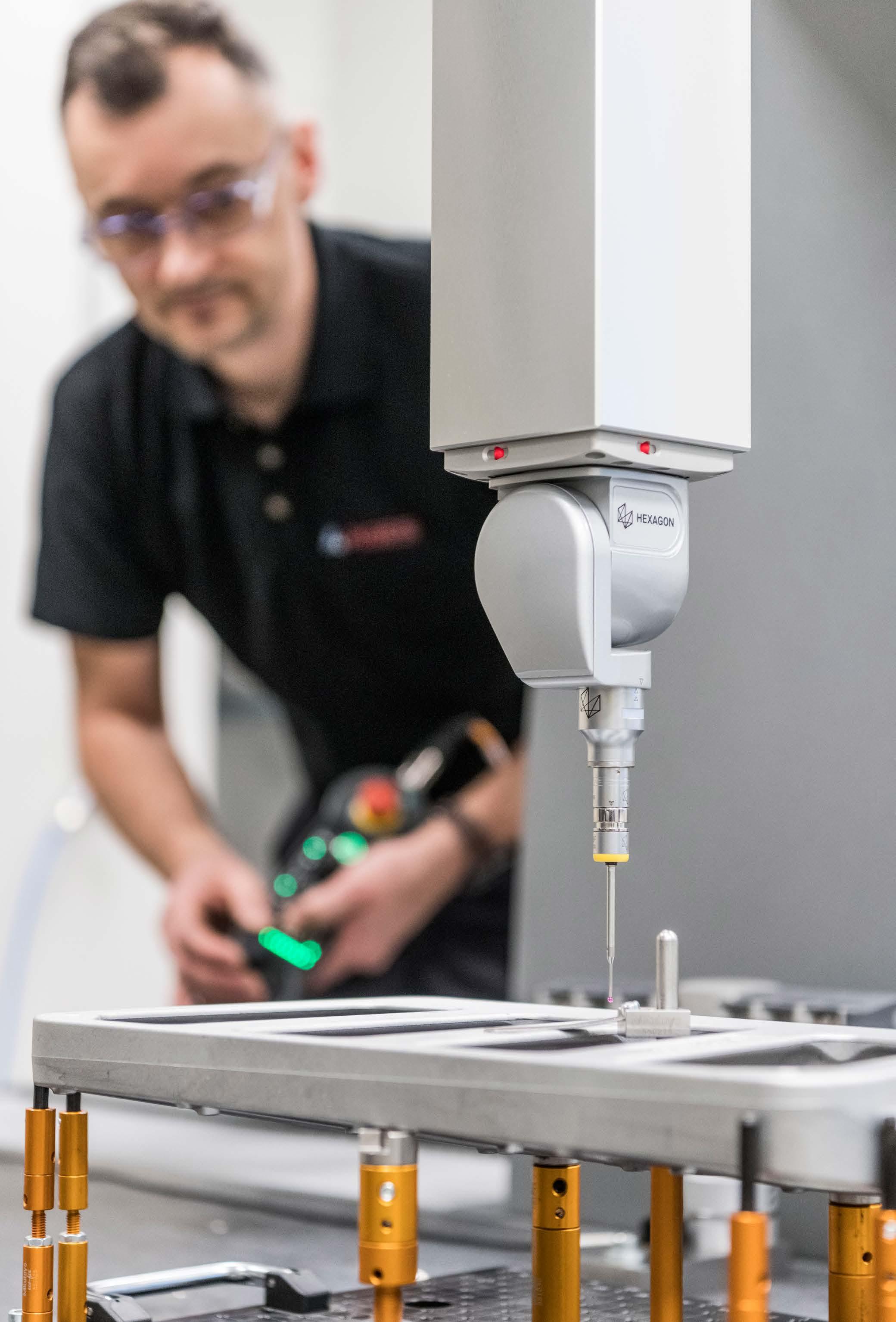

(All amounts are reported in SEK thousand, unless otherwise stated.)
The company AGES Industri AB (publ), corporate identity number 556234-6204, carries on business activities as a limited company and its registered office is in Halmstad municipality in Sweden. The address of the head office is PO Box 815, SE-301 18 Halmstad. All amounts are reported in SEK thousand, unless otherwise stated.
The annual accounts have been prepared in accordance with the Swedish Annual Accounts Act and recommendations and statements by the Swedish Financial Reporting Board.
The Parent Company applies the same accounting policies as the Group, except in the cases shown below. The Parent Company’s financial statements have been prepared according to Recommendation RFR 2 Financial Reporting for Legal Entities of the Swedish Financial Reporting Board. The deviations that occur between the Parent Company’s and the Group’s policies are caused by limitations in the scope to apply IFRS to the Parent Company as a result of the Swedish Annual Accounts Act and, in some cases, for tax reasons. For information on the impact of new standards issued by IASB on the Parent Company’s accounting policies, see Note 2 Group Accounting policies.
Exchange rate differences in the business’s receivables and liabilities are recognised in operating profits, while exchange rate differences attributable to financial receivables and liabilities are recognised in net financial income/expense.
In accordance with Recommendation RFR 2 Financial Reporting for Legal Entities of the Swedish Financial Reporting Board, the Parent Company applies the exemption under IFRS 16 with effect from 1 January 2019. This means that the Parent Company recognises lease payments as operating expenses through profit or loss on a straight-line basis over the lease term for all leases.
Of the Parent Company’s net sales, 100 per cent (100) comprised billing of subsidiaries. There are significant financial receivables and liabilities between the Parent Company and subsidiaries which accrue interest at the market rate.
In addition to what is set out in Note 3, Board members and senior executives have not received dividends in accordance with the decision taken by the AGM.
As the owner, the Parent Company has a related party relationship with its subsidiaries, see Note 12. Viem Invest AB, controlled by Anna Benjamin, and Pomonagruppen AB, in which Board member Fredrik Rapp has a controlling interest, are major shareholders in AGES. No dividends were paid and no transactions took place between these shareholders and AGES.
Participations are measured according to the cost method. Dividends from subsidiaries are recognised as income. The items are tested for impairment annually and the participations measured at the highest consolidated value, i.e. the subsidiary’s adjusted equity plus consolidated surplus values.
Cash flow is recognised by applying the indirect method. This means that the net profit/ loss is adjusted for transactions that have not resulted in cash inflows or outflows during the period and for any income and costs related to the cash flows of investing or financing activities.
Because of the relationship between accounting and taxation, the rules regarding financial instruments in IFRS 9 are not applied in the Parent Company as a legal entity. The Parent Company instead applies the cost method in accordance with the Swedish Annual Accounts Act. The Parent Company therefore measures financial fixed assets at cost and financial current assets according to the lower of cost and net realisable value, with application of expected credit loss impairment under IFRS 9 for assets accounted for as debt instruments. For other financial assets, impairment is based on market value.
Revenue
The Parent Company offers its subsidiaries services relating to business development, organisation, finance, etc. Revenue from services is recognised in the period in which the service is carried out. Intra-group sales take place at market price.
Group contributions
Group contributions are recognised in accordance with the alternative rule of recommendation RFR 2, according to which Group contributions paid and received are recognised as appropriations through profit or loss.
Taxes
Recognised income taxes include tax payable for the current year and changes to deferred tax. Measurement of tax assets and tax liabilities is based on nominal amounts and calculated using tax rules and tax rates that have been enacted. Deferred tax is calculated on the basis of temporary differences which arise between the carrying amount and the tax bases of assets and liabilities.
Deferred tax liabilities are normally recognised for all taxable temporary differences while deferred tax assets are recognised to the extent that it is probable that the amounts will be utilised.
Because of the relationship between accounting and taxation, the Parent Company recognises the deferred tax liability relating to untaxed reserves as part of untaxed reserves.
Subsidiaries’ claims on and debts to internal lines of credit are recognised as liabilities and receivables in respect of Group companies. The Group’s total receivable/liability in respect of the bank is recognised as a receivable or liability in the Parent Company. Interest at the market rate is applied to the subsidiaries’ claims and debts.
Remuneration of Board members and senior executives
Decisions and completed proposals for guidelines relating to remuneration of Board members and senior executives, see Note 4 Group.
Audit engagement refers to the review of the annual accounts, interim financial reporting, the administration by the Board of Directors and CEO and the corporate governance report.
Future minimum lease payments under non-cancellable operating leases at the end of the reporting period are due as follows:
Parent Company’s operating leases primarily relate to leases for premises and vehicle leases.
Operating lease costs in the Parent Company in the financial year amounted to SEK 282,000 (SEK 401,000)
(All amounts are reported in SEK thousand, unless otherwise stated.)
The subsidiaries comprise 5 industrial companies. The other companies have limited operations of type sales company, holding company, property company or dormant company.
1) All subsidiaries have internal bank overdraft facilities linked to AGES Industri AB’s Group account system. The unused portion is recognised as a net amount. The Parent Company’s cash and cash equivalents, including external credit granted but not utilised, totalled SEK 44,771 million on the balance sheet date. Cash in hand and at bank included overdraft available balance, Group foreign currency accounts.
Amount at the disposal of the Annual General Meeting: SEK
There were no significant events after the reporting period.
The Board of Directors and the CEO propose that these funds be appropriated as follows: SEK
The undersigned certify that the consolidated financial statements and annual accounts have been prepared in accordance with international financial reporting standards IFRS, as adopted by the EU, and generally accepted accounting principles, and that they give a true and fair view of the position and performance of the Group and Company, and that the Directors’ Report for the Group and Company gives a fair review of the development and performance of the business and the position of the Group and Company together with a description of the principal risks and uncertainties facing the companies that form part of the Group.
The annual accounts and consolidated financial statements for AGES Industri AB (publ) for the financial year 2022 have been authorised for issue by the Board of Directors.
The Annual Report will be presented for adoption to the Annual General Meeting on 4 May 2023.
Halmstad, 30 March 2023
Our Auditor’s Report was submitted on 30 March 2023. Ernst & Young AB
Carolina Birch AUTHORISED PUBLIC ACCOUNTANT
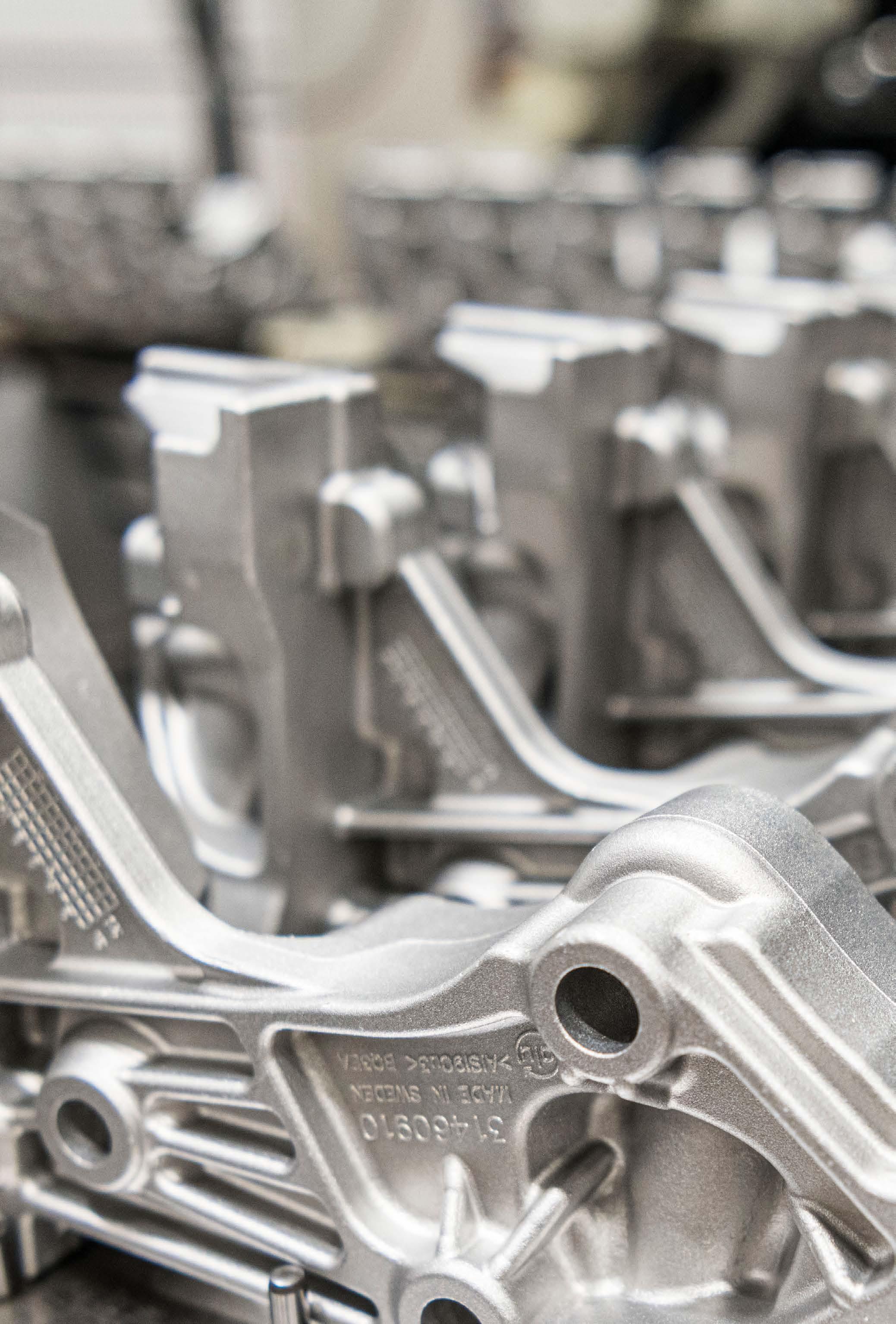
To the Annual General Meeting of AGES Industri AB (publ) AB, corporate identity number 556234-6204 Report on the annual accounts and consolidated accounts
We have audited the annual accounts and consolidated accounts of AGES Industri AB (publ) for the financial year 2022. The Company’s annual accounts and consolidated accounts are included on pages 38–75 of this document.
In our opinion, the annual accounts have been prepared in accordance with the Swedish Annual Accounts Act and present fairly, in all material respects, the financial position of the Parent Company as at 31 December 2022, and its financial performance and cash flows for the year then ended in accordance with the Swedish Annual Accounts Act. The consolidated financial statements have been prepared in accordance with the Swedish Annual Accounts Act and present fairly, in all material respects, the financial position of the Group as at 31 December 2022, and its financial performance and cash flows for the year then ended in accordance with International Financial Reporting Standards (IFRS), as adopted by the EU, and the Swedish Annual Accounts Act. The Directors’ Report is consistent with the other parts of the annual accounts and consolidated financial statements.
We therefore recommend that the Annual General Meeting adopt the income statement and balance sheet for the Parent Company and the Group.
We conducted our audit in accordance with International Standards on Auditing (ISA) and generally accepted auditing standards in Sweden. Our responsibilities under these standards are further described in the section Auditor’s responsibilities. We are independent of the Parent Company and the Group in accordance with professional ethics for accountants in Sweden and have otherwise fulfilled our ethical responsibilities in accordance with these requirements.
We believe that the audit evidence we have obtained is sufficient and appropriate to provide a basis for our opinions.
The Board of Directors and the CEO are responsible for this other information. This other information consists of a description of the business on pages 1–37 (but does not include the annual accounts, consolidated financial statements or our auditor’s report regarding these).
Our opinion on the annual accounts and consolidated financial statements does not include this information and we do not and will not express an opinion verifying this other information.
In connection with our audit of the annual accounts and consolidated financial statements, it is our responsibility to read the information identified above and consider whether the information is materially inconsistent with the annual accounts and consolidated financial statements. In this review we also take into account the knowledge we have obtained in the audit and assess whether the information otherwise appears to contain material misstatements.
If, based on the work carried out with respect to this information, we conclude that there is a material misstatement in this other information, we are required to report that fact. We have nothing to report in this respect.
The Board of Directors and CEO are responsible for the preparation and fair presentation of the annual accounts and consolidated financial
statements in accordance with the Swedish Annual Accounts Act and, in respect of the consolidated financial statements, in accordance with IFRS, as adopted by the EU. The Board of Directors and CEO are also responsible for such internal control as they determine is necessary to enable the preparation of annual accounts and consolidated financial statements that are free from material misstatement, whether due to fraud or error.
In the preparation of the annual accounts and consolidated financial statements, the Board of Directors and CEO are responsible for assessment of the company’s ability to continue as a going concern. They disclose, where appropriate, information on conditions that may affect the ability to continue as a going concern and to use the going concern basis of accounting. However, the going concern basis of accounting is not used if the Board of Directors and CEO intend to liquidate the company, discontinue operations or do not have a realistic alternative to either of these actions.
Our objectives are to obtain reasonable assurance about whether the annual accounts and consolidated financial statements as a whole are free from material misstatement, whether due to fraud or error, and to issue an Auditors’ Report that includes our opinions. Reasonable assurance is a high level of assurance, but is not a guarantee that an audit conducted in accordance with International Standards on Auditing (ISAs) and generally accepted auditing standards in Sweden will always detect a material misstatement when it exists. Misstatements can arise from fraud or error and are considered material if, individually or in aggregate, they could reasonably be expected to influence the economic decisions of users taken on the basis of these annual accounts and consolidated financial statements.
As part of an audit according to ISA, we exercise professional judgement and maintain professional scepticism throughout the audit. We also:
∣ identify and assess the risks of material misstatement in the annual accounts and consolidated financial statements, whether due to fraud or error, design and perform audit procedures responsive to those risks, and obtain audit evidence that is sufficient and appropriate to provide a basis for our opinions. The risk of not detecting a material misstatement resulting from fraud is higher than for a material misstatement resulting from error, because fraud may involve collusion, forgery, intentional omissions, misrepresentations or the override of internal control procedures.
∣ obtain an understanding of the company’s internal control relevant to our audit in order to design audit procedures that are appropriate in the circumstances, but not for the purpose of expressing an opinion on the effectiveness of the company’s internal control.
∣ evaluate the appropriateness of accounting policies used and the reasonableness of accounting estimates and related disclosures made by the Board of Directors and the CEO.
∣ form a conclusion on the appropriateness of the Board of Directors’ and the CEO’s use of the going concern basis of financial statements. We also draw a conclusion, based on the audit evidence obtained, as to whether any material uncertainty exists related to events or conditions that may cast significant doubt on the company’s ability
to continue as a going concern. If we conclude that a material uncertainty exists, we are required to draw attention in our auditor’s report to the related disclosures in the annual accounts or, if such disclosures are inadequate, to modify our opinion about the annual accounts and consolidated accounts. Our conclusions are based on the audit evidence obtained up to the date of our auditor’s report. However, future events or conditions may cause a company to cease to continue as a going concern.
∣ evaluate the overall presentation, structure and content of the annual accounts and consolidated financial statements, including the disclosures, and whether the annual accounts and consolidated financial statements represent the underlying transactions and events in a manner that achieves fair presentation.
∣ obtain sufficient and appropriate audit evidence regarding the financial information of the entities or business activities within the Group to express an opinion on the consolidated financial statements. We are responsible for the direction, supervision and performance of the group audit. We remain solely responsible for our opinions.
We must inform the Board of Directors of, among other things, the planned scope, direction and timing of the audit. We must also inform of significant audit findings during our audit, including any significant deficiencies in internal control that we identified.
In addition to our audit of the annual accounts and consolidated financial statements, we audited the Board of Directors’ and CEO’s administration of AGES Industri AB (publ) for the financial year 2022 and the proposed appropriation of the company’s profit or loss.
We recommend to the Annual General Meeting that the profit be appropriated as proposed in the Directors’ Report and that the members of the Board of Directors and the CEO be discharged from liability for the financial year.
We conducted our audit in accordance with generally accepted auditing standards in Sweden. Our responsibilities in accordance with these are described further in the section Auditor’s responsibilities. We are independent of the Parent Company and the Group in accordance with professional ethics for accountants in Sweden and have otherwise fulfilled our ethical responsibilities in accordance with these requirements.
We believe that the audit evidence we have obtained is sufficient and appropriate to provide a basis for our opinions.
The Board of Directors is responsible for the proposed appropriation of the company’s profit or loss. Dividend proposals include an assessment of whether the dividend is justifiable considering the demands that the nature, scope and risks of the company’s and Group’s operations place on the amount of equity in the Parent Company and the Group, and on the consolidation requirements, liquidity and financial position in general of the Parent Company and the Group.
The Board is responsible for the organisation of the company and the management of its affairs. Among other things, this includes continuously assessing the financial position of the company and the Group and ensuring that the company’s organisation is designed such that controls of accounting records, asset management and the company’s financial circumstances in general are performed in a satisfactory manner. The CEO must take charge of the day-to-day management in accordance with the Board’s guidelines and directives, including taking the necessary measures to ensure that the company’s accounting records are complete according to law and that asset management is conducted satisfactorily.
Our objective for the audit of the administration, and thereby our opinion on discharge from liability, is to obtain audit evidence to enable us to determine with reasonable assurance whether any member of the Board or the CEO has, in any material respect:
∣ taken any action or been guilty of any negligence that may result in a claim for compensation being brought against the company, or
∣ in any other way acted in contravention of the Swedish Companies Act, the Swedish Annual Accounts Act or the Articles of Association.
Our objective for the audit of the proposed appropriation of the company’s profit or loss, and thereby our opinion on this matter, is to determine with reasonable assurance whether the proposal is consistent with the Swedish Companies Act.
Reasonable assurance is a high level of assurance, but is not a guarantee that an audit conducted in accordance with generally accepted auditing standards in Sweden will always detect actions or omissions which may result in a claim for compensation being brought against the company, or that the proposed appropriation of the company’s profit or loss is inconsistent with the Swedish Companies Act.
As part of an audit according to generally accepted auditing standards in Sweden, we exercise professional judgement and maintain professional scepticism throughout the audit. The examination of the administration and the proposed appropriation of the company’s profit or loss is based primarily on the audit of the accounts. Any additional audit procedures performed are based on our professional judgement with risk and materiality as the starting point. This means that we focus the examination on such actions, areas and circumstances that are material for the operations and where deviations and violations would be of particular importance for the company’s situation. We review and test decisions taken, supporting information for decisions, actions taken and other circumstances that are relevant to our opinion concerning discharge from liability. As a basis for our opinion on the Board of Directors’ proposed appropriation of the company’s profit or loss, we have examined whether the proposal is in accordance with the Swedish Companies Act.
Jönköping. 30 March 2023
Ernst & Young AB
Carolina Birch AUTHORISED PUBLIC ACCOUNTANT
AGES Industri AB (publ); AGES Class B shares have been listed on Nasdaq Stockholm First North Premier Growth Market since 16 May 2014. The company’s Class A shares are not listed.
Corporate governance in Swedish listed companies is regulated by a combination of written rules and practices. Legislation mainly consists of the Swedish Companies Act and the Swedish Annual Accounts Act, as well as the rules that apply in the regulated market on which the company's shares are listed for trading. In addition, all listed Swedish companies are covered by the Swedish Code for Corporate Governance (“the Code”) since 2008. Guidelines concerning the Code can be found on the website of the Swedish Corporate Governance Board (www. bolagsstyrning.se). The Code complements legislation by setting stricter requirements in certain areas, but simultaneously makes it possible for companies to deviate from these in certain circumstances if this is believed to lead to better corporate governance, provided that an explanation is given about the deviation.
The purpose of AGES Industri’s corporate governance is to create a clear division of roles and responsibilities between the owners, board, board committees and group management and create long-term value for shareholders and other stakeholders.
Corporate governance in AGES Industri is primarily based on application of the Swedish Companies Act, Nasdaq Stockholm First North Premier Growth Market’s regulations, the Code and internal guidelines and rules.
The share capital at the end of 2022 stood at SEK 35.1 million, distributed between a total of 7,028,974 shares on the balance sheet date, of which 1,822,200 were Class A shares and 5,206,774 were Class B shares. One Class A share carries 10 votes per share and one Class B share carries one vote. All shares have equal rights to the company’s assets and dividends. At the end of 2022, AGES had 1,229 shareholders. The ten largest shareholders held 85.5% of the capital and 95.7% of the votes. As at the balance sheet date, two shareholders each controlled more than 10 per cent of both the equity and votes in the company. Anna Benjamin and her companies control 28.8% of the shares and 57.9% of the votes. Pomonagruppen AB holds 29.9% of the shares and 29.7% of the votes.
The general meeting of shareholders is the forum at which shareholders exercise their influence over the company and it is the company’s highest decision-making body, being superior to the company’s Board of Directors and CEO. In accordance with the Articles of Association, a general meeting of shareholders must be called through a notice in the official gazette Post- och Inrikes Tidningar and on the company's website. An announcement of the notice must be published in the Dagens Industri newspaper.
The Annual General Meeting convenes once a year to, among other things, adopt the annual financial statements and consolidated financial statements, discharge the Board of Directors and CEO from liability and pass a resolution on appropriation of profits for the financial year just ended. The Annual General Meeting also elects the Board of Directors and, if required, the auditor. All shareholders who are directly registered in the share register and who have registered their attendance in time can attend the meeting and use their voting rights. Shareholders who are unable to attend in person may be represented by a proxy.
AGES Industri AB’s Annual General Meeting was held on 3 May 2022 and was attended by 10 shareholders, whose combined holdings corresponded to 91% of the votes and 60% of the outstanding shares.
AGES’ Board of Directors and management, together with the auditors and representatives of the Nomination Committee, were present at the meeting. The following key decisions were taken:
∣ Adoption of the income statements and balance sheets for 2021, allocation of profits and discharge from liability for the Board of Directors and CEO.
∣ Stefan Jonsson was re-elected Chairman of the Board.
∣ Anna Benjamin, Fredrik Rapp, Anders Berggren and Petra Öberg Gustafsson were re-elected as members of the Board of Directors.
∣ Election of auditor Ernst & Young AB, with Carolina Birch as the Auditor in Charge.
∣ Ulf Hedlundh, Anna Benjamin and Per Rodert were re-elected to the Nomination Committee, with Ulf Hedlundh re-elected Chairman.
∣ Guidelines for remuneration of senior executives.
∣ Resolution to approve the Board’s proposal for guidelines for remuneration terms and other terms and conditions of employment for senior executives.
∣ Resolution on authorisation for new issue.
AGES Industri AB’s Annual General Meeting will be held on 4 May 2023 at 15:00 CEST at the company’s head office at Halmstad University, Kristian IV:s väg 3.
Further information is available on page 87 of the Annual Report for 2022 and at www.ages.se.
The Nomination Committee is the general meeting’s body responsible for preparing recommendations for appointments for ratification by the general meeting and its purpose is to establish a sound basis for the general meeting’s consideration of these matters.The 2022 Annual
General Meeting appointed a Nomination Committee comprising Ulf Hedlundh as the Chairman, Anna Benjamin and Per Rodert. The task of the Nomination Committee prior to the 2023 Annual General Meeting is to propose a Chairman of the Board of Directors and other Board members, auditors, a chairman for the AGM, Board committees, and fees for the auditors. In its proposal to the Board, the Nomination Committee must propose Board members who are the most suitable candidates for the company, based on an overall assessment of relevant skills and experience, while also taking into consideration the need for diversity and breadth on the Board, as well as gender balance.
According to AGES Industri’s Articles of Association, the Board of Directors must be composed of at least three and not more than eight members.
The 2022 Annual General Meeting resolved that the number of Board members should be five. The Board of Directors has comprised Stefan Jonsson (Chairman), Fredrik Rapp, Anna Benjamin, Anders Berggren and Petra Öberg Gustafsson.
Fredrik Rapp and Anna Benjamin are not considered to be independent in relation to major shareholders. Other Board members are judged to be independent in relation to both major shareholders and the company and its group management.
The Board of Directors is responsible for the organisation of the Company and management of the company’s operations. The Board of Directors also issues guidelines and instructions to the CEO. The Board of Directors must also ensure satisfactory control of the organisation of the company with regard to reporting, management of funds and financial position. The Board of Directors follows rules of procedure that are revised annually and adopted at the first scheduled board meeting following election.
The Chairman of the Board is responsible for ensuring that the Board’s work is well organised, performed efficiently and that the Board fulfills its duties. The Chairman of the Board is elected by the general meeting.
The Chairman of the Board is responsible for the evaluation of the work of the Board of Directors, including assessments of the performances of individual Board members. This is carried out an annual basis through a structured process. The evaluation findings are presented to the Nomination Committee and form the basis for the Nomination
The Board of Directors held 7 meetings in the reporting period. The agenda for each ordinary meeting includes regular reporting items and decisions, as well as information on the business, in accordance with the Board of Directors’ rules of procedure. The Board of Directors also decides on issues of an overarching nature, such as the Group’s strategy, structural and organisational matters. as well as major investments. One of the company’s auditors participates in at least one Board meeting per year. The auditor’s observations arising from the audit of the company’s accounts, procedures and internal controls are presented at this meeting.
The Board of Directors has two committees, the Audit Committee and Remuneration Committee.
The Audit Committee must prepare the work of the Board of Directors by performing quality assurance of the company’s financial reporting, regularly meeting the company's auditor to inform themselves of the company's direction and scope as well as discussing the coordination of the external and internal audit and the view of the company's risks, establishing guidelines for services other than auditing that can be provided by the company’s auditor, evaluating the audit work and informing the company’s Nomination Committee of the outcome of the evaluation, as well as assisting the Nomination Committee in preparing its proposals for auditors and fees for the audit work. AGES’ Audit Committee in 2022 comprised Anna Benjamin.
The Remuneration Committee must prepare recommendations relating to remuneration and other employment terms and conditions for the company’s group management. AGES Industri AB’s Remuneration Committee is composed of Chairman of the Board Stefan Jonsson and Board members Fredrik Rapp and Anna Benjamin.
The Board appoints a CEO to manage the day-to-day administration of the company. The current CEO is Anders Magnusson.
Group management in the reporting period comprised CEO Anders Magnusson and CFO Johan Bladh.
1) Anna Benjamin and Fredrik Rapp are not considered to be independent in relation to major shareholders in their capacity as shareholders. This is also the overall assessment Further information about the Board of Directors in 2022 is available at www.ages.se and also on page 84 of the printed version of the Annual Report.
The Annual General Meeting on 3 May 2022 adopted the Board’s proposal for guidelines for remuneration of the CEO and senior executives. The key principles for remuneration and other terms and conditions of employment of the CEO and other senior executives are that AGES must offer its senior executives remuneration on market terms. The guidelines cover basic salary, variable remuneration, pension benefits and other benefits and severance pay.
No signficant changes are proposed ahead of the 2023 Annual General Meeting regarding the principles for remuneration and other terms and conditions of employment of the CEO and senior executives. For a full description of the proposed guidelines, see Note 4, page 53.
A Corporate Governance Report was prepared by AGES Industri AB for the financial year 2022. The Corporate Governance Report is available on the company’s website. The Corporate Governance Report for 2022 was subject to examination by the auditor in accordance with the attached auditor’s statement.
A Sustainability Report was prepared by AGES Industri AB. The Sustainability Report is available on the company’s website www.ages.se.
The auditor shall audit the company’s Annual Report and accounts and the administration of the company by the Board of Directors and CEO. According to the Articles of Association, the Annual General Meeting shall appoint a registered public accounting firm or 1-2 auditors, at least one of whom must be an authorised public accountant. Fees to auditors will be paid against an approved invoice.
Based on the composition of the Group and the size of the Group, AGES Industri AB decided not prepare a remuneration report for 2022 and instead refers to Note 4, which provides detailed and itemised reporting of remuneration.
In accordance with the Swedish Companies Act and the Code, the Board of Directors is responsible for internal controls, which are aimed at protecting the company’s assets and thereby the shareholders’ investments.
All AGES Industri units report their financial results every month. These reports are consolidated and form the basis for monthly reports, quarterly reports and operational follow-up. This operational follow-up is carried out in accordance with an established structure where invoicing, liquidity, capital management and other key ratios for the Group are collated and form the basis for analysis and measures by management and controllers.
The basis for internal control related to financial reporting consists of an overarching control environment. The main task of the Audit Committee is to monitor accounting and reporting processes and to ensure the quality of these reports and processes. Responsibility for maintaining an effective control environment and the ongoing work concerning risk management and internal controls related to financial reporting rests with the CEO. Managers at various levels within AGES Industri have this responsibility within their respective areas. Responsibilities and powers are defined in the CEO’s instructions, instructions concerning authorisation rights, manuals and other policies, procedures and codes. The Board of Directors establishes the Group’s key policies concerning communication, financing and risk management. Group management establishes other policies and instructions, and responsible corporate functions issue guidelines and monitor application of the regulations. The Group’s accounting and reporting regulations are set out in a finance manual which is available to all finance personnel. Together with laws and other external regulations, the organisational structure and internal regulations constitute the control environment.
There is a risk that material misstatement could occur in the financial statements in connection with accounting and measurement of assets, liabilities, income and expenses or deviations from information requirements. Each year, AGES’ finance function carries out a risk assessment of the group's balance sheet and income statement items based on qualitative and quantitative risks.
Standard control activities include account reconciliation and supporting controls. The purpose of all control activities is to prevent, detect and correct any errors or deviations in financial reporting. The most significant risks related to financial reporting identified as a result of the Group’s internal control activities are managed through control structures that in all material respects are based on deviation reporting from established goals or standards..
The Group applies IFRS, which are defined in AGES’ audit manual. The manual covers accounting and measurement regulations that must be followed by all companies within the Group, together with reporting instructions. Financial information is reported on a monthly basis by all legal entities.
Each Board member receives a monthly report containing consolidated income statements and balance sheets for the Group.
The Group’s financial position is discussed at each meeting of the Board of Directors. The finance division and management perform a detailed analysis of financial reporting on a monthly basis.
It is the opinion of the Board of Directors that the company is in compliance with the Swedish Code of Corporate Governance.
Halmstad, 30 March 2023
Magnusson CEOTo the Annual General Meeting of AGES Industri AB (publ) AB, corporate identity number 556234-6204
The Board of Directors is responsible for the Corporate Governance Report for 2022 on pages 78–80 and for ensuring that it is prepared in accordance with the Swedish Annual Accounts Act.
Our examination has been carried out in accordance with FAR’s auditing standard RevU 16 Auditor’s examination of the Corporate Governance Report. This means that our examination of the Corporate Governance Report has a different direction and is significantly less in scope than the direction and scope of an audit conducted in accordance with International Standards on Auditing and generally accepted auditing standards in Sweden. We believe that this examination provides sufficient basis for our opinions.
A Corporate Governance Report has been prepared. Disclosures in accordance with Chapter 6, Section 6, paragraph 2, items 2–6 of the Swedish Annual Accounts Act and Chapter7, Section 31, paragraph 2 of the same Act are consistent with the financial statements and consolidated financial statements and are in accordance with the Swedish Annual Accounts Act.
Jönköping. 30 March 2023
Ernst & Young AB
Carolina Birch
AUTHORISED PUBLIC ACCOUNTANT
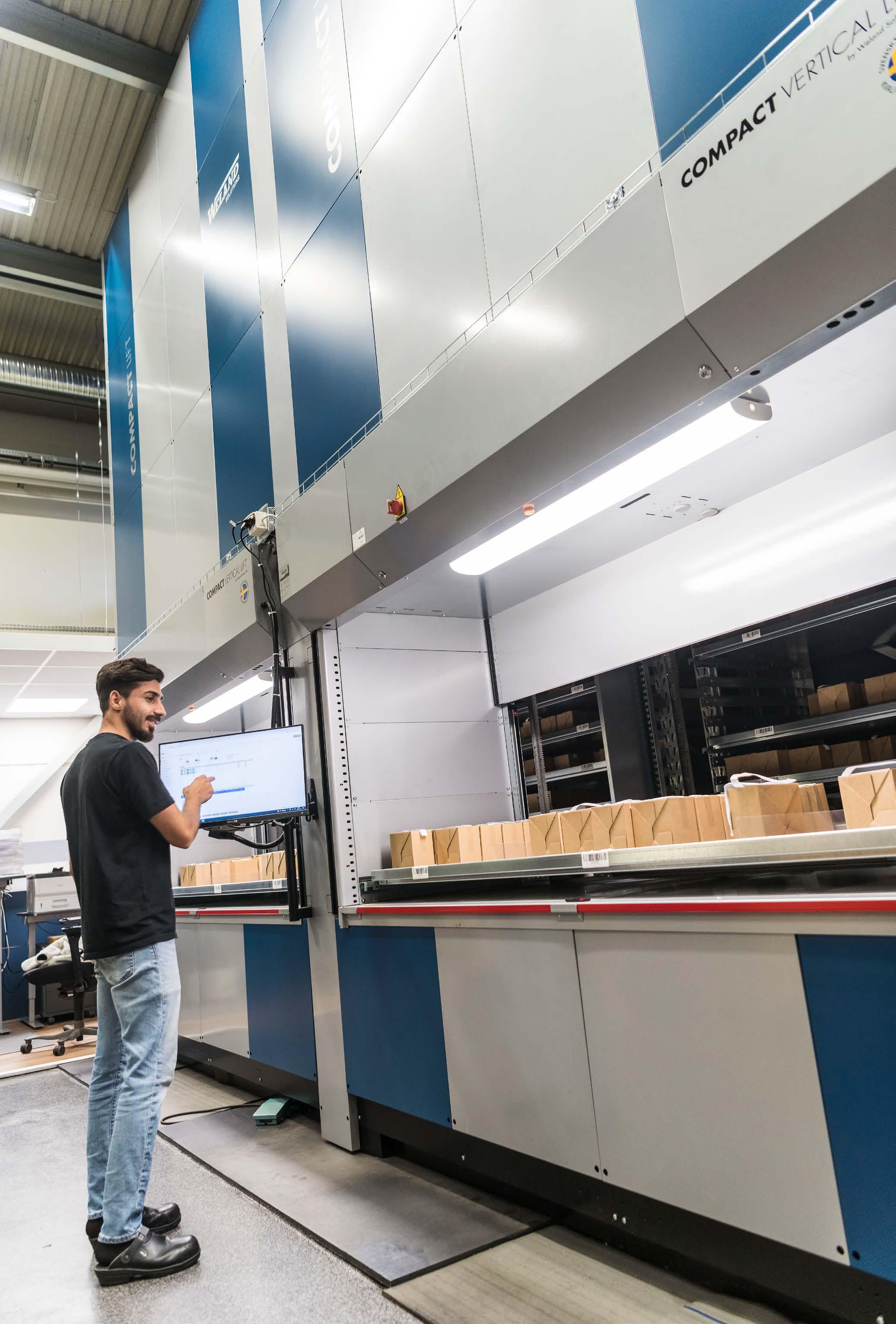
Percentage of risk-bearing capital
Equity plus provisions for tax in relation to total assets.
Return on equity
Profit for the year in relation to average equity.
Return on capital employed
Profit after financial income/expense after reversal of financial expenses in relation to average capital employed.
Return on total assets
Profit after financial income/expense after reversal of financial expenses in relation to average total assets.
Gross margin
Gross profit in relation to net sales.
Dividend yield
Proposed dividend in relation to the share price on the balance sheet date.
Equity per share
Equity in relation to the number of outstanding shares on the balance sheet date.
Cash flow from operating activities per share
Cash flow from operating activities in relation to the average number of outstanding shares.
Earnings/loss per share
Profit for the year in relation to the average number of outstanding shares.
Diluted earnings/loss per share
Profit for the year in relation to the average number of outstanding shares, plus the average number of shares that will be added on conversion of outstanding warrants.
Interest coverage ratio
Profit after financial income/expense after reversal of financial expenses in relation to financial expenses.
Operating margin
Operating profit in relation to net sales.
Equity/assets ratio
Equity in relation to total assets.
Capital employed
Total assets less non interest-bearing liabilities.
Total assets
Total equity and liabilities (total assets).
Profit margin
Pre-tax profit in relation to net sales.
Chairman, elected 2018.
Education: Engineering degree 4 years 1973, group management at IFL Sigtuna 1991.
Professional experience: CEO of GARO AB, Head of division at SAPA AB, Deputy CEO of Pallco AB.
Other directorships: Chairman of Axjo Plastic AB, Flåren AB, Hörle Wire Group AB, Stefan Jonsson Invest AB and S Jonsson Consulting AB. Board member of Axjo America Inc and Fiber Fenix Ek Förening.
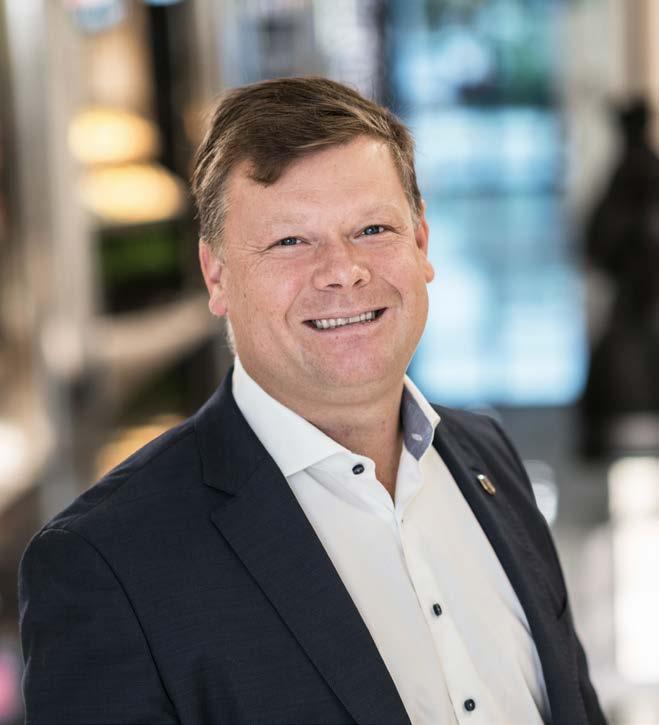
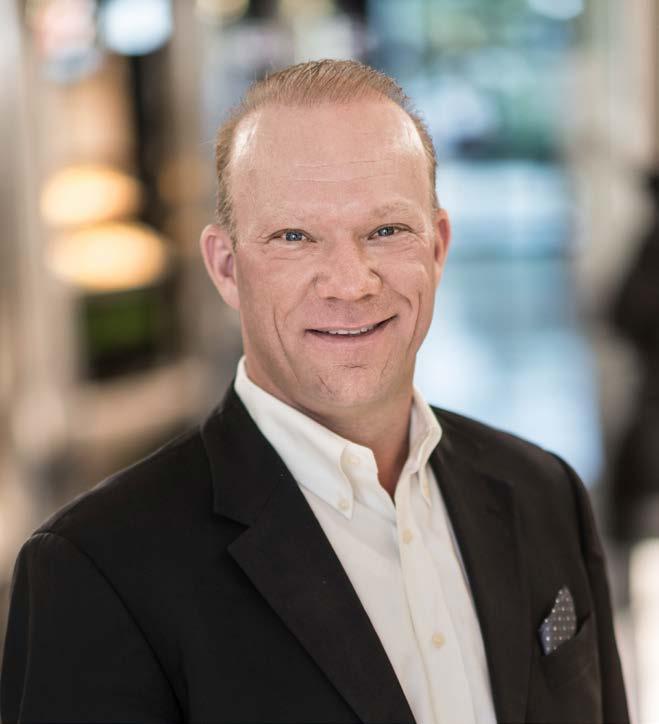

Shareholding in AGES: 0.
Board member, elected 2013.
Education: MSc in Business and Economics.
Professional experience: CEO of Pomona-gruppen, Investment manager Pomona-gruppen, CEO of Talk Telecom.
Other directorships: Chairman of e.g. XANO Industri AB (publ), Argynnis Group AB, Estinvest AB, Serica Consulting AB, Svenska Handbollsförbundet. Board member of e.g. ITAB Shop Concept AB (publ), Corem Property Group AB (publ), Pomona-gruppen AB, PrimeKey Solutions AB and Segulah AB.
Shareholding in AGES: 540,000 Class A shares and 1,567,045 Class B shares.
Board member, elected 2015.
Education: MSc in Economics, Jönköping International Business School.
Professional experience: Business development ICA
Sverige AB, Manager PricewaterhouseCoopers, Controller Nobina.
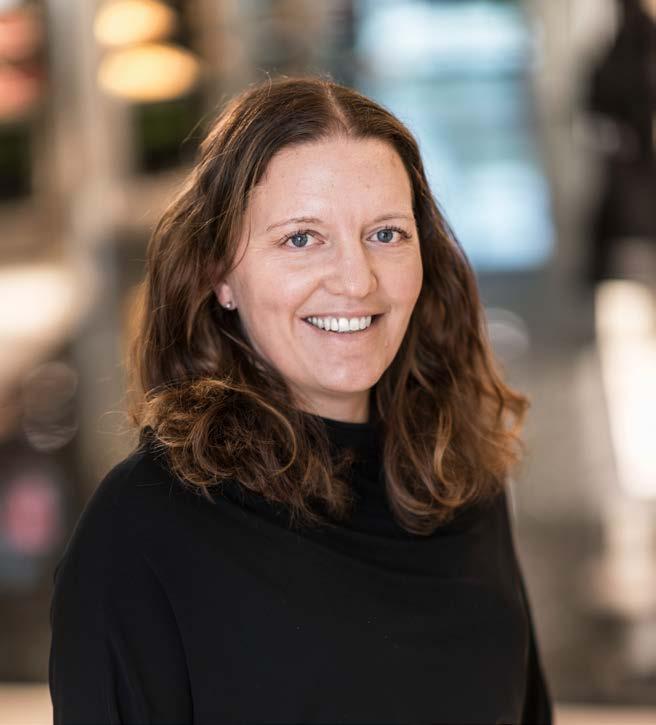
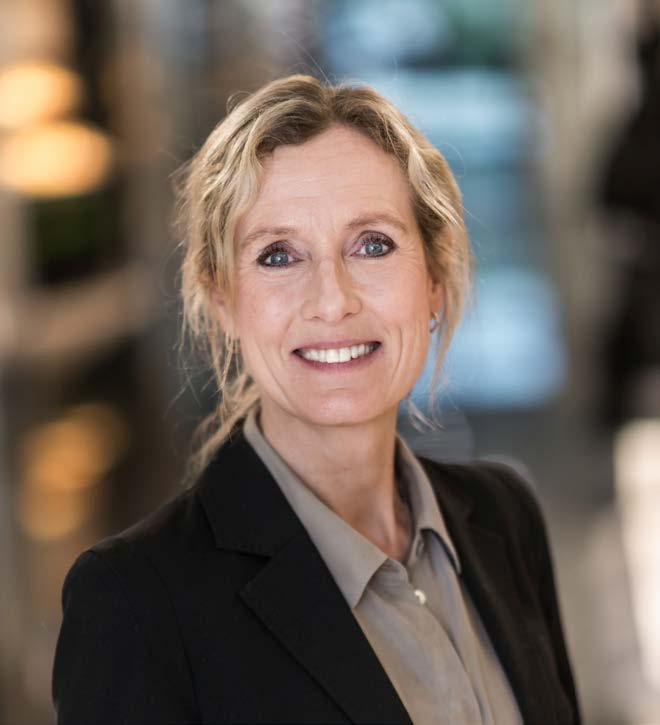
Other directorships: Board member of XANO Industri AB (publ), ITAB Shop Concept AB (publ), Hand in Hand Sweden, INEV AB, among others.
Shareholding in AGES: 1,282,200 Class A shares and 737,800 Class B shares.
Board member, elected 2020.
Education: MSc in Engineering (Industrial Economics), Linköping University 1995, Harvard Business School Executive Program 2007.
Professional experience: Executive Advisor Partner in Wind Point Partners USA, Head of Business Area in Marmon Holdings Inc. USA, a number of managerial positions in Husqvarna AB.
Other directorships: Board member of Dacke Industri AB and Axjo Plastic AB and advisor to Wind Point Partners.
Shareholding in AGES: 20,000 Class B shares.
Board member, elected 2021.
Education: International marketing.
Professional experience: Several managerial positions at SKF in sales and Product Management and CEO of TengTools AB.
Other directorships: Board member of Uveco AB and HM Albretsen.
Shareholding in AGES: 0.
CFO since 2013.
Education: MSc in Business and Economics.
Professional experience: Business area controller Getinge Infection Control, Group controller Getinge AB, auditing KPMG.
Shareholding in AGES: 8,000 Class B shares and 50,000 warrants.
CEO, employed since 2017.
Education: Mechanical engineer.
Professional experience: Founder, owner and CEO of Hörle Gruppen AB.


Shareholding in AGES: 240,000 Class B shares through ANO i Värnamo AB and 50,000 warrants.
Authorised Public Accountant, elected 2022. Ernst & Young Jönköping.
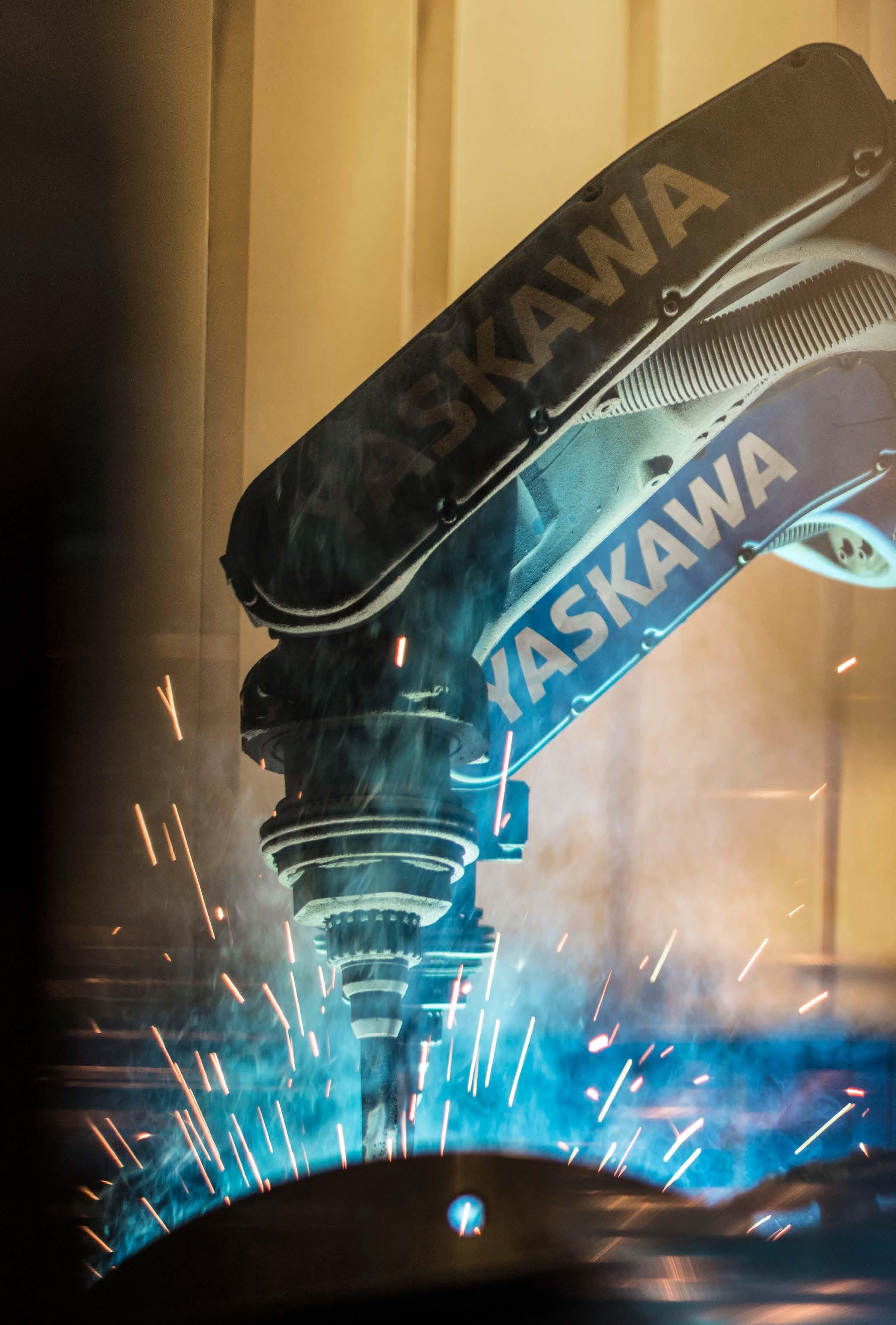
Notice is hereby given that the Annual General Meeting of AGES Industri AB (publ) will be held on Tuesday 4 May 2023 at 15:00 CEST at Restaurant Mangold, Halmstad University, Kristian IV:s väg 3, 302 50 Halmstad, Sweden.
Notice Shareholders who wish to attend the Annual General Meeting must (i) be entered in the register of shareholders maintained by Euroclear Sweden AB as at 25 April 2023 and (ii) must notify the company of their intention to participate in the Annual General Meeting not later than by 16:00 on Friday 28 April 2023 either by post to AGES Industri AB, PO Box 815, SE-301 18 Halmstad, by telephone to +46 (0)706 048 382 or by email to arsstamma @ ages.se. A registration form can be obtained from www.ages.se
To be entitled to participate in the Annual General Meeting, shareholders who have registered their shares in the name of a nominee must, in addition to confirming their attendance at the AGM, re-register their shares in their own name so that the shareholder is entered in the shareholder register as at 25 April 2023. Such registration may be temporary (so-called voting rights registration) and should be requested from the nominee in accordance with the nominee’s procedures and giving advance notice as determined by the nominee. Voting rights registration completed not later than 27 April 2023 will be taken into consideration in the preparation of the shareholder register.
Dividend The Board of Directors proposes to the Annual General Meeting that no dividend be paid.
Nomination Committee The 2022 Annual General Meeting appointed a Nomination Committee comprising Ulf Hedlundh as the Chairman, Anna Benjamin and Per Rodert. The task of the Nomination Committee ahead of the 2023 Annual General Meeting is to propose the Chairman of the Board of Directors and other Board members, auditors, a chairman for the AGM and fees for the Board of Directors, committees and auditors.
Business The Annual General Meeting shall conduct such business as according to the Swedish Companies Act and the Articles of Association should be conducted at Annual General Meetings, including presentation of the Annual Report and Auditor’s Report, resolutions on adoption of the income statement and balance sheet, discharge from liability for Board members and the CEO, and election of Board members and auditors.
Other agenda items will be stated in the notice of the Annual General Meeting, published in the official Swedish gazette Post och Inrikes Tidningar and on the company's website not later than four weeks before the meeting.
AGES Industri AB (publ), PO Box 815, SE-301 18 Halmstad
Visiting address: Kristian IV:s väg 3, Apt. 13, SE-302 50 Halmstad agesindustri @ ages.se www.ages.se Corporate identity number 556234-6204
AGES Casting Unnaryd AB
Hyltevägen 1
SE-314 51 Unnaryd
Tel. +46 (0)371 622 00
AGES Värnamo AB PO Box 308
SE-331 23 Värnamo
Visiting address: Silkesvägen 11
Tel. +46 (0)370 69 23 30
AGES Falkenberg AB
Kabelvägen 10
SE-311 50 Falkenberg
Tel. +46 (0)346 71 50 00
AGES Kulltorp AB
Gnosjövägen 10
SE-335 96 Kulltorp
Tel. +46 (0)370 836 60
UB Verktyg AB
Mjölnarevägen 6
SE- 331 73 Bor
Tel. +46 (0)370 65 88 80
AGES Hörle AB
PO Box 436
SE-331 24 Värnamo
Visiting address: Hörle 3
Tel. +46 (0)370 33 37 00
AGES Shared Services AB
Hörle 3
SE-331 92 Värnamo
Tel. +46 (0)370 65 07 00
AGES Ningbo
Hörle Automatic (Ningbo) Co.Ltd
No.108 JinChuan Road
Nordic Industrial Park
Zhenhai, Ningbo 315221
P.R. China